Archived on 30th December 2018 A pleasant enough day on Friday (28th) for our annual Christmas walk around Budworth Mere / Haydn's / Neumann's etc. - overcast but dry with a maximum temperature of 12 ° C. It was nice to see our Hon. Sec. Derek back out in the field and in great form! and also Hon. Treasurer Frank who survived a 10 hour drive up from Kent the previous day - sheer weight of traffic with cars queuing in the slip roads up to the services on the M25 and M6; how on earth are we to cope in the future when all these vehicles need their batteries 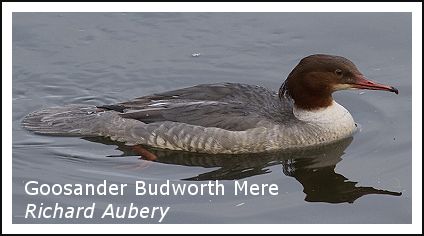 charging when we're all electric? charging when we're all electric?Our route took us from the Witton Bridge car park up to Haydn's pool, along to Budworth Mere then over to Neumann's Flash on our way back to the cars. Dunnocks, Great and Blue Tits were all in song as we approached Butterfinch Bridge, no Cetti's Warbler this year but a Water Rail called briefly from deep inside the reedbed upstream from the bridge. Haydn's Pool was disappointing; it's currently overgrown with little water to be seen, but we did tick off Stock Dove and Peregrine on the day list - the latter perched on a railing on the old ICI building, not in it's usual position on the chimney - you can't hide from the Hon. Chairman's Swarovski! Elevenses were taken at the viewing screen overlooking Budworth Mere. More to see here, the most obvious species on view were the Goosanders - no less than 29 birds, four full adult males but mostly "red heads" one of which was fishing in the shallows, just below the screen, where Richard obtained the image shown above. A second Water Rail was heard from here whilst out on the mere good numbers of Great Crested Grebes two of which were displaying. Over towards the sandspit were the gulls, Mainly Black-headed with a few Herring a handful of Lesser Black-backed and a single Great Black-backed. Other wildfowl included Shoveler, Tufted Duck, Little Grebe with a couple of Canada Geese and a lone Goldeneye. A Kingfisher flew low over the mere as we made our way along the waterside path and into the woodland. Approaching Neumann's we came across a small flock of finches predominately Green and Gold but alongside them a couple of Lesser Redpolls. More Wildfowl on Neumann's with Wigeon and Teal present in good numbers; across on the far side of the flash a flock of c. 200 Lapwings (but no Golden Plovers this time). Richard, Geoff and Sheila diverted to Pod's hide before returning to the cars and from there had a Snipe and great views of a Water Rail which was so close that Richard was able to capture this shot with his phone camera. In the foreground you'll see red roses left in memory of Pete "Pod" Antrobus and in who's memory the hide was erected. A poignant image and a reminder that for many people Christmas and New Year can be a very difficult time. Some up and coming dates for your diary. Friday 4th January.... The latest CAWOS meeting - Paul Hobson "Scotland" 7:45pm at the Catholic Church, Tatton Street, Knutsford.Sunday 6th January.... Our KOS January field trip to Connah's Quay. 08:30am at the Tatton Street car park or 09:20 at the entrance to the reserve. Hopefully the Twite flock has built up again this winter. Sunday 13th January... Wildfowl watch with the Tatton Rangers. 11:00am to 1pm at the Allen hide. Friday 25th January... KOS indoor meeting - "North Norfolk Here I Come" with Jim Almond Saturday 26th January - Big Garden Birdwatch with the Friends of Knutsford Moor. 9am to 10am on the Moor. Sunday 27th January - Big Garden Birdwatch with the Friends of Knutsford Heath 11am to noon on the Heath.
Greetings all. A lovely evening last Friday rounded off our 2018 meeting programme with festive spirits fuelled by a delicious food offering. This event is also our sole fund raising effort of the year; here is how we did on that front. A total of twenty one people attended the party; a figure lower than in previous years owing to a number of late cancellations from members felled by various bugs. Nevertheless, the evening was a great success on the financial as well as the enjoyment front, coming in the top three of KOS parties for money taken and profit recorded. The two occasions when slightly more was raised were years when we had guest lists of twenty eight. Based on the size of our gathering, it was the most financially productive party that we have ever had. Admission money at £ 7 per head raised £ 147.00 The raffle organised by Sue and Jacquie brought in £ 54.10 The bring and buy stall, followed by the end of evening auction, overseen by Sheila and Judith realised £ 54.40 Various donations totalled £ 53.00 This produced a total revenue of £ 308.50. Deducting modest buffet costs of £ 51.50 (all the offerings being subsidised in some way by the providers) gave a profit of £ 257.00 So a big thank you to all involved in our party, for supporting the raffle and the bring and buy, for providing the food and making donations. Also to Bob for organising a quiz and providing the prize. The sum raised will help keep the Society going and enable us to continue to attract quality speakers to our meetings. Frank Thanks Frank it looks as though we'll not have to post that begging letter to Jose Mourinho who's apparently leaving Old Trafford with a golden goodbye of £ 18 million!I've not received many sightings of interest since the last update. Bob Groom was at Rostherne on 11th December and had a flock of c.100 Pinkfeet flying over. In Mobberley along Pavement Lane two Little Owls have taken over the oak tree nest site used two years ago by a pair of Barn Owls. Blue, Great and Coal Tits have been in song for the past couple of weeks and were joined over the weekend by the local Dunnocks. Not long now to the shortest day and in the garden the daffodil leaves are beginning to emerge - Spring can't be that far away - or am I being a tad too optimistic? In his weather column in today's Times Paul Simons, who correctly predicted the arrival of the "Beast from the East" at the end of February, seems confident that were going to suffer something similar in the near future, possibly as soon as late December although more likely in mid to late January. It could run through to February with hard frosts, ice and snow - you've been warned! I've updated the trips and meetings page with three additional outdoor events. On December 28th we'll be having our Christmas walk around the Northwich Woodlands - Neumann's / Haydn's / Budworth Mere etc. meeting at the usual Witton Bridge car park at 09:45 for a 10am start. 09/12/2018...... A wet day in Wigan
No surprises this time but the hoped for specialities were all recorded. Lesser Black-backed and Black-headed Gulls, Coot, Mallard and Tufted Duck were viewable from the car park with an Oystercatcher sheltering from the drizzle 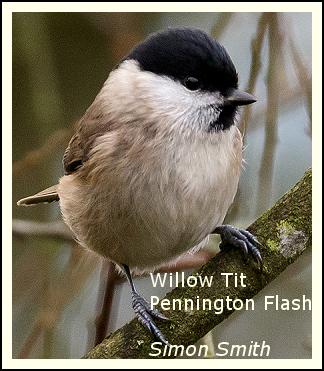 under a park bench. Cormorant, Great Crested Grebe, Goldeneye, Shoveler, Mute Swan and Canada Goose were added to the day list as we made our way around the flash in a clockwise direction and it wasn't long before it's characteristic call alerted us to the presence of a Willow Tit. It was very active and gave excellent views as it move quickly from perch to perch just a few yards from where we stood - top bird but a species we seem to have lost from the Knutsford area. At the top end of the flash, more Goldeneye and good views of a female Goosander - a species well down in number this year. A flock of a dozen or so Lapwings made a brief appearance, apart from the Oystercatcher the only waders we saw all day, whilst returning via the muddy waterside tracks commoner species such as Goldfinch, Pied Wagtail, Redwing, Goldcrest and Mistle Thrush were ticked off our list. under a park bench. Cormorant, Great Crested Grebe, Goldeneye, Shoveler, Mute Swan and Canada Goose were added to the day list as we made our way around the flash in a clockwise direction and it wasn't long before it's characteristic call alerted us to the presence of a Willow Tit. It was very active and gave excellent views as it move quickly from perch to perch just a few yards from where we stood - top bird but a species we seem to have lost from the Knutsford area. At the top end of the flash, more Goldeneye and good views of a female Goosander - a species well down in number this year. A flock of a dozen or so Lapwings made a brief appearance, apart from the Oystercatcher the only waders we saw all day, whilst returning via the muddy waterside tracks commoner species such as Goldfinch, Pied Wagtail, Redwing, Goldcrest and Mistle Thrush were ticked off our list.We just made it to the hides in time for lunchtime butties as the skies darkened and a period of heavy rain set in. The hides proved to be quite productive, especially the bunting hide where the well stocked feeders were proving popular with members of the Tit family - Great, Blue, Coal but only a single Willow plus new species for the day like Stock Dove, Reed Bunting and Nuthatch. The Wirral is proving very popular at the moment with KOS members, including Bob and Glynn who enjoyed a productive day on Tuesday (4/12)..........Glynn and I went over to Burton Mere this morning and clocked 6 species of raptor, only Merlin was missing. A ring-tail Hen Harrier was around the whole time we were there, mostly perched but several times hunting the scrape and the reedbed. A handsome male Sparrowhawk caught the sun as it sat on the ground and on low foliage across the water. A female Marsh Harrier flew over and back, a dashing Peregrine twice put everything up, including the geese. A Kestrel appeared, looking surprisingly pale at first. Two Buzzards hung around, feeding on invertebrates at times. I counted 62 Whooper Swans. There were also a couple of Black Swans and a few Mute Swans. A Little Egret ignored the raptors and stayed put. There were the usual Black-Tailed Godwits, Redshanks and Snipe plus a few Ruff and Dunlins. A Kingfisher flashed past and Greenfinches visited the feeders. We moved on to Parkgate, no owl appeared unfortunately, but we had further views of Marsh Harriers and another ringtail Hen Harrier. There were a couple of Great White Egrets, many Curlews, Pink-Footed Geese and a Stonechat. Although we had travelled through banks of fog en route, the Estuary was bathed in hazy sunshine and so visibility was quite reasonable......... Closer to home Hugh Pulsford tell me he ringed four Cetti's Warblers on Knutsford Moor in late September / early October so hopefully we'll have them breeding next Spring - we've waited long enough now!
We had good views of thousands of Pink footed Geese on our recent visit to the excellent reserve at Lunt Meadows (see 22/10/2018), nice enough but it's more exciting (in my opinion) to have them on your "local patch". I say "on" that should really be "over" as, here on the Cheshire plain, you're much more likely to have them passing over many hundreds (or even thousands) of feet up, rather than on the ground, as they commute between the Lancashire mosslands and Norfolk. 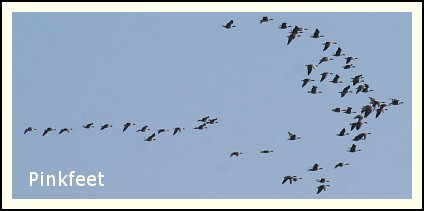 Invariably it's the sound that first grabs your attention before you actually see them high overhead in loose "V" formations - constantly calling - a timeless, wild and evocative sound that can send a shiver down your spine! Invariably it's the sound that first grabs your attention before you actually see them high overhead in loose "V" formations - constantly calling - a timeless, wild and evocative sound that can send a shiver down your spine!At this time of the year it's usual for Pinkfeet to be seen heading for the east coast but two flocks on Sunday (25th) were going west, 60 over Mobberley at 11:15am (TU) with 125 seen from Queensway by Bob Groom. The following day (Mon.26th) things were back to normal when Darren Morris reported 100+ heading east over Tatton and a few hours later Bob watched a passage consisting of "at least" 1000 birds over Rostherne Mere travelling in the same direction. The Starling roost in the Coward reedbed at Marbury Park's Budworth Mere continues, long-time visitor to this website Wendy Stratford paid a couple of visits last week and reports Keith Offord's talk about Harriers last Friday was much appreciated by a disappointingly small audience, Keith is an articulate speaker with a relaxed style making the most complex of subjects easy to understand. Perhaps inspired by Keith's excellent talk potential new member Karina Stanley travelled over to the Wirral on Sunday where she was successful in her search for Hen Harriers and had good views of both male and female/immature birds. The day after this CAWOS meeting it's our KOS December field trip over to Pennington Flash (Saturday 8th December - leaving Lilac Avenue at 9:00am)- Willow Tits and Goosanders guaranteed! Another local group visited the flash yesterday [click here] a good total but we should do better than that! 21/11/2018...... Tatton A chilly morning in Tatton with a temperature of only 5C and a brisk easterly wind, not a problem for a hardy group of mid-weekers just one or two extra layers required - don't wish your life away waiting for Spring and the warmer weather! 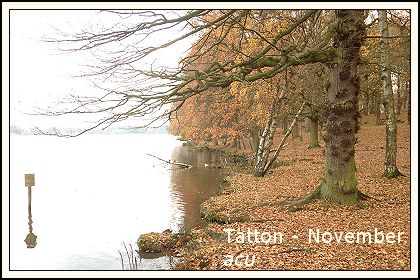 We began in Dog Wood before moving along to the Allen hide overlooking Melchett Mere via the top path past the outdoor centre. Elevenses were enjoyed in the hide before returning along the western side of the main mere and Knutsford Moor. 5.72K with 63 meters of ascent according to my phone app. - boys' toys! Dog Wood was quiet although we did come across a flock of Goldfinches feeding in the path side Alder Trees and a small flock of Redwings flew into the topmost branches of an Oak tree. Some activity on the south end of Tatton Mere with Great Crested Grebe, Mallard, Tufted Duck, Canada Goose, a couple of Little Grebes and small scattered groups of Pochard. A reminder that on Friday (23rd) we have our November indoor get together when we'll be welcoming back Keith Offord who'll be telling us all about the "Skydancers".
14/11/2018......Marbury murmuration The Starling population in Britain continues to decline at an alarming rate with an 80% fall since 1979 and 33% in the last 10 years alone [RSPB]. Despite this ( and pre-Brexit uncertainty!) visitors from abroad help boost the Winter population in the UK and the pre-roost gatherings or "murmurations" can be spectacular and encourage large audiences of birders and non-birders to favoured locations. A couple of years ago a friend in the Knutsford Photographic Society captured an image of the birds going to roost at Neumann's Flash and, using a system of grids, estimated that the flock contained 400,000 Starlings! An email to Bob Groom from Jacquie Ledward alerted us to the fact that a substantial murmuration was building up at Marbury Country Park where the birds were going to roost in the Coward reedbed and on Sunday (12th) Jacquie had seen Sparrowhawks and a Peregrine attacking the Starlings prior to them reaching relative safety in the reeds. Bob and I went along to Marbury yesterday afternoon (13th) and were in position for about 3:30pm. The first Starlings began to arrive half an hour later and the flock quickly built up until there were quite a few thousand swirling around, not in the hundreds of thousands but it's early days yet. (I took a video on my phone [below]). No Peregrine yesterday but we had good views of a tiny male Sparrowhawk chasing a starling just above the surface of the mere. Millions of years of evolution helped the starling outrun it's pursuer which normally relies on a surprise attack! It's well worth a visit - view from the screen overlooking the Coward reedbed.
Western Parotia....Red Bird of Paradise....Wilson's Bird of Paradise....Vogelkop Bower bird
12/11/2018......Moore and Marbury A better than likely day weather wise for our KOS double header on Saturday (10/11) to the Moore Nature Reserve in the morning and Marbury in the afternoon. Moore's not the most attractive of venues but it was doing its best and looked quite respectable in it's Autumn coat of gold and yellows, enhanced on this occasion by a stream of brightly attired runners taking part in the Warrington 40 mile ultra marathon - yes four zero, forty miles! The winning solo runner managed it in less than five hours! As they passed us they were at the 25 mile mark, only 15 more to go. We were impressed 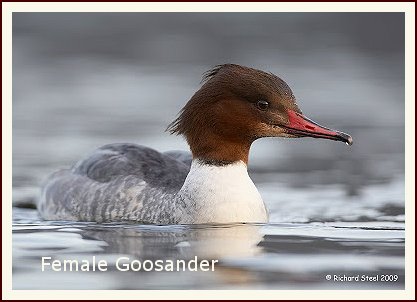 that each and every one of them gave a cheery smile and wave as they trundled by! that each and every one of them gave a cheery smile and wave as they trundled by!We managed about three miles in the two hours we spent on the reserve, perhaps a bit more due to some navigation issues at the far and of the walk! Redwings, Chaffinches and Blackbirds were feeding in a hawthorn bush next to the car park as we left in the direction of Lapwing Lake where we noted Kingfisher, Gadwall, Moorhen, Coot, Mute Swan, Wigeon, Little Grebe, Tufted Duck and Mallard - a good start. The feeding station was disappointing in that, in the past, this was the place locally for Willow Tit and even Lesser Spotted Woodpecker, but no sign on Saturday, although we did have Blue, Great, Coal Tit and Nuthatch. Birchwood Pool was also very quiet, in days gone by it would be filled with gulls that fed on the recently closed landfill site on the banks of the River Mersey, just a few hundred yards away. Little to report from the far end of Moore just a few Teal and Shoveler and a single Black-tailed Godwit before the long trudge back to the cars. On then to Marbury where the car parking is no longer free and a warning here - they've installed new state of the art ticket machines that are as user friendly as a cornered rat. Luckily we had Geoff Blamire with us and with his logical approach to this sort of problem soon translated the hieroglyphics etched into the front of the machine and persuaded it to grant us 3 hours for
£
1.50!
Alan Booth tells me that on 31/10 he had a male Pintail and the first Goldeneye of the season on the main mere in Tatton Park with a male and three female/juvs.- thanks Alan. Redwings and Fieldfares are currently passing through in good numbers, 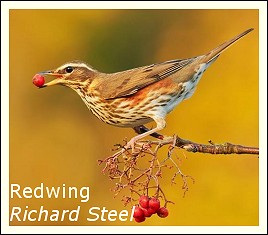 this morning in Mobberley a flock of 20 Fieldfares passed over Smith Lane and a handful of Redwings and Blackbirds were feeding on Hawthorn berries at the roadside. this morning in Mobberley a flock of 20 Fieldfares passed over Smith Lane and a handful of Redwings and Blackbirds were feeding on Hawthorn berries at the roadside.No Fieldfares and just distant views of what were probably flocks of Redwings last Wednesday (31/10) during what was a disappointing mid-week visit to Woolston Eyes. We managed just 33 species during the morning with remarkably few small birds on the well-stocked feeders, no Willow Tits, just a few Greenfinches and Blue and Great Tits. So the highlight of the day was the safe re-appearance of Geoff and Sheila Blamire after their latest expedition, this time to West Papua in search of the elusive Birds of Paradise, Sheila describes photography as "very, very difficult" so it will hopefully be another interesting account of their travels in April at the next KOS AGM!! This coming Saturday's KOS November field trip should be less of a challenge for our intrepid adventurers as we head west for a double-header; Moore Nature Reserve in the morning WA46XE. Then over to Marbury Mere CW9 6AT where lunch will be taken. I think the catering van is still operating on a Saturday and as I recall the bacon butties are well worth queuing for!
There was some excitement yesterday morning at Burton Mere as a small group of mid-weekers arrived for a mornings birding. It wasn't our appearance that caused the increased activity amongst the local ornithological glitterati but the sighting (or rather just the call) the previous day (23rd October) of the reserve's first Bearded Reedling. We had no luck positioned at the appropriate spot, but according to Al Orton's bird blog 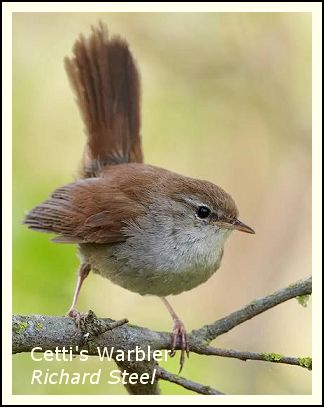 one was seen from there later in the day; the blog also mentions Water Pipit and Curlew Sandpiper; we didn't see these either - Perhaps we were missing some key personnel! one was seen from there later in the day; the blog also mentions Water Pipit and Curlew Sandpiper; we didn't see these either - Perhaps we were missing some key personnel!Despite these "failures" we amassed a creditable list of 58 species on the reserve with a further three being added later by a small splinter group who moved on to Parkgate (I hope you kept out of the Parkgate Chippie chaps)! As usual we began in the visitor centre where some of us enjoyed a cup of the excellent RSPB filter coffee ( £ 1.80) as we scanned the main pool and the adjacent reedbeds. There was plenty of activity - Lapwing, Black-tailed Godwit, Dunlin, Curlew, Ruff, Redshank and Snipe were all on view whilst further out in the distance single Whooper Swans and Cattle Egret, a Great White Egret gave great views as it lumbered past in the direction of the Dee Estuary. Canada Geese and Greylags were both around in good numbers and flocks of Pinkfeet came and went throughout the morning. IMF (the hide at Inner Marsh Farm) provided new species with a flock of 18 Golden Plover mixed in with 15 Dunlin, this was where the Curlew Sandpiper had been located but we couldn't make it out - one of the locals said he could see it in his 'scope but was a bit vague with his directions so we never got onto it. Tomorrow evening (Friday 26th) it's our October indoor meeting when Jeff Clarke will be talking about "The Humboldt".
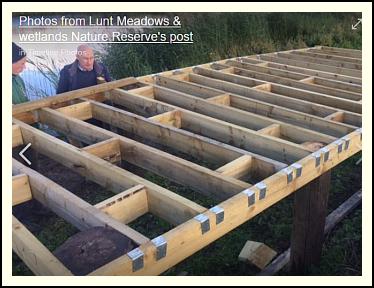 The weather was excellent, 16C, mostly overcast but with a few sunny intervals; the reserve is very flat and open and currently has only viewing screens - not the place for a rainy day! Having said that I see from their excellent Facebook page that the volunteers are currently constructing a "proper" hide with a roof overlooking reedbed #2. (download a map of the reserve here) The weather was excellent, 16C, mostly overcast but with a few sunny intervals; the reserve is very flat and open and currently has only viewing screens - not the place for a rainy day! Having said that I see from their excellent Facebook page that the volunteers are currently constructing a "proper" hide with a roof overlooking reedbed #2. (download a map of the reserve here)A short distance from the spacious car park is the main pool, a shallow area of water which held a good selection of birds - Shoveler, Teal, Moorhen, Grey Heron, Little Egret, Black-tailed Godwit, and a handsome Whooper Swan gliding effortlessly along. On the muddy margins good numbers of Lapwings and well-hidden Common Snipe that took to the air from time to time, no sign though of the Jack Snipe that had been seen earlier in the morning. As we moved on towards the screen overlooking reedbed #1 Meadow Pipits and Skylarks were constantly on the move overhead but the most obvious species were the Pink-footed Geese that arrived in huge, noisy skeins from the north to feed on the fields the other side of the River Alt; lots of guesses as to the number present but suffice it to say that there were many thousands! A Stonechat posed nicely for us before a big female Sparrowhawk hunting low over the ground scattered everything in sight including all the waders on the Main Pool, there were more Snipe than we thought - probably in excess of 50 birds. Further round the reserve a Buzzard gave good views through the 'scopes as it rested on the ground whilst a tractor passing close to the Pinkfeet forced them into the air along with a female Marsh harrier. The two small pools on our left as we walked back towards the car park held more Lapwings, Black-tailed Godwits and two Ruff - an excavator was parked close by,it's being used to make more wet areas with scrapes and breeding islands. Finally as they enjoyed lunch sat on a bench overlooking reedbed #1 and to round off a most rewarding visit Bob, Jacquie and Sue had a Peregrine and fleeting views of a Bittern bringing the day list to 47. Our thanks go to Bob and Sue for suggesting a visit to Lunt Meadows and to Sue for acting as trip leader - we'll no doubt be returning in the near future. It appears "The Lad" is heading for home after only 35 days in a tent on the Shetlands - no staying power these youngsters nowadays - typical snowflake!
16/10/2018...... More Winter birds seen Our Winter visitors are slowly beginning to appear; I had my first Redwing of the Autumn last Wednesday (10/10) along Smith Lane in Mobberley and today, at the same location, a chattering Fieldfare 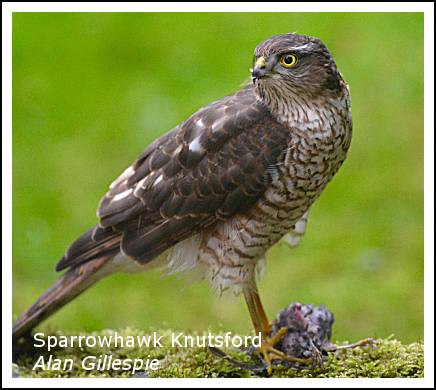 flying west was a welcome sight and sound. A couple of hours later in Tatton park Darren Morris had a flock of Pink-footed geese passing over heading in a north-westerly direction, again a first record of the season. flying west was a welcome sight and sound. A couple of hours later in Tatton park Darren Morris had a flock of Pink-footed geese passing over heading in a north-westerly direction, again a first record of the season.Birds are flocking to the gardens of those that provide them with food, Derek and Jean were delighted to welcome a Grey Wagtail to their garden in Lilac Avenue (it was enjoying their new water feature) and in Bucklow Avenue we've more Goldfinches than ever before, with up to 30 at a time feeding on sunflower hearts (no need for the complications of nyjer seed, sunflower hearts are much better [we get ours from a place in Altrincham, they deliver free to your door if you're local (Knutsford and Mobberley on a Thursday) and we've found them very reliable. 20Kg for £ 25 as opposed to 900gms for £ 2 on Knutsford Market ≡ £ 44.50 for 20KG]). This concentration of birds will of course attract predators like the juvenile male Sparrowhawk pictured here in Alan Gillespie's back garden in Knutsford, feeding on a House Sparrow; it remained long enough for him to dig out his camera! - thanks Alan, nice image. "The Lad" is still up in the Shetlands, and is currently on Fetlar in search of a Snowy Owl. Hi there Tone, A final reminder that our next field trip will take place this Saturday (20th October) when we'll be visiting a new venue - Lunt Meadows on Merseyside ( L29 7WL) - 45 mins from Knutsford - 9am at Lilac Avenue. 07/10/2018......First of the Winter ThrushesThe first ground frost of the autumn this morning in Mobberley, although my weather station showed a minimum of only +1.9C, just above freezing a foot or so above ground. Quite fitting then that the first Redwing of the season appeared on Thursday (4th) with Darren Morris reporting a single bird in Tatton Park These delightful  little Winter visitors, together with their close cousins - the larger Fieldfares, should become widespread as we move into the colder months. The Redwings migrate at night and on a clear evening at this time of the year can be heard calling as they pass overhead during the hours of darkness at a height of about 100' - listen carefully for a single quiet, short "seeep". little Winter visitors, together with their close cousins - the larger Fieldfares, should become widespread as we move into the colder months. The Redwings migrate at night and on a clear evening at this time of the year can be heard calling as they pass overhead during the hours of darkness at a height of about 100' - listen carefully for a single quiet, short "seeep".There are still a few Summer visitors around; House Martins have been recorded this week and Geoff and Sheila had a female Blackcap (30/9) and a Chiffchaff (3/10) in their Mere garden - although of course some hardy individuals of both species spend the Winter with us nowadays. On his return from experiencing the raptor passage in the Tarifa region of southern Spain Bob Groom's first port of call was "his" Hobby site just outside Knutsford, but he had no luck and it's presumed they've moved south for the Winter after what appears to have been a successful breeding season. Only 7 Winter months to wait before they're back with us Bob! Last Friday's (26th September) first indoor get together of the season was well-attended, I counted 30 members and visitors who'd gathered to watch Michael Leach's presentation "The Complete Owl". Michael's been a wildlife cameraman with the BBC and has authored a number of books; he gave a very informative and polished presentation, although,in my opinion, his images left something to be desired. Judging by the label on the feeder (left), seen in the Poundstretcher store in Northwich it appears that Pied Flycatchers have evolved into seed eaters without anyone noticing! Don't forget our next field trip will take place on Saturday 20th October when we'll be visiting a new venue - Lunt Meadows on Merseyside - 45 mins from Knutsford - 9am at Lilac Avenue. 25/09/2018...... Latest news from Rostherne, Tatton and the Shetlands. As predicted the gale force winds last week (18,19,20 September) produced some good records from the coast. Al Orton's excellent birding blog reported Little Gull, Sabine's Gull, Long-tailed Skua, 9+ Leach's Petrel, 2 Grey Phalarope, Great Northern Diver, Great Skua, 6 Arctic Tern and a Black Tern. from New Brighton and at Hoylake - Probable Great Northern Diver, Long-tailed Skua (juv), 4 Leach's Petrel, Grey Phalarope, 47 Golden Plover and a Ruff. I spent a few hours at Rostherne, a Spotted Flycatcher in front of the obs. provided some entertainment but there was no sign of any wind blown vagrants. Derek was in Tatton at the same time and also drew a blank although on Sunday (23rd) the Manchester Birding Forum had a nice record of a Black Tern over Tatton's Melchette Mere and yesterday, on a return visit, Derek had a Jack Snipe in the Melchette reed bed. These tiny winter visitors arrive every autumn at this location but are rarely reported as they're notoriously difficult to find and remain on the deck until you're about to step on them! Barrie "The Lad" Armitt is on his travels again and, true to form, has chosen a challenging environment - he's camping in the Northern Islands of Scotland. Hi Tone Yep. Back on Unst ...Sat in hostel ...Rain hammering down...double staked the tent in preparation for tonight. Good bird today...Buff-Breasted Sand...total lack of passerines other than Goldcrest . .Think they know what's on the way and have scarpered. Bits and bobs last couple of days: Pied Fly, Rosefinch, Wood Warbler, YBW, usual Phylloscs. Consensus is it's quiet..until the American turned up today ?? Regards Baz Hi Tone No NE sadly...stuck with NW-W ...No real movement...Most passerines here look to have been here a while. Some good birds though: American Golden Plover and Buff breasted Sand feeding together; Citrine Wag.. couple of Barred Warbler; Spotshank - rare here- 5+ Common Rosefinch; Wood warbler still here; Whinchat, handful of Willow Warbler and Chiffchaff; couple of Pied Fly. Something is lurking out there?? Changed tents last night to check the new bomb proof edition ahead of wild camp on Fetlar...managed to pitch it so the fabric played a demonic "tune" half the night in the wind...Having an easy morning as consequence. Take it easy...... Baz Thanks Baz. As entertaining as ever - keep in touch!There's a good Shetland facebook page here plus a second here and a third (non-facebook) here This Friday (26th) it's the first of our new season of indoor meetings when Michael Leach will be talking about "The Complete Owl" - Based on Michael's best-selling book of the same name. This talk reveals our resident British owls in folklore and fact; it looks at barn owls and tawny owls, little owls and cat owls and the specialised techniques that help them hunt. It dispels misleading myths and reveals the realities of an owl's life. The talk is illustrated with dramatic high-speed photographs of owls in flight Same time and same place - hope to see you all there!17/09/2018...... Field Trip to North Wales
Derek has kindly sent me a short summary of the day including a list of species seen. Driving along the A55 and about 5miles short of Llanfairfechan we had a tremendous downpour and a person in our car (unnamed) said "take me home Derek", but arriving at Llanfairfechan Frank our Hon. Treasurer enjoyed the day as well......Overall I think it was a very successful day. Obviously the weather helped. I definitely think it was a good idea to visit North Wales at this time of the year. Stretched out on the sea front at Llanfairfechan eating lunch at the end of our walk felt positively blissful..... No doubt helped by the fact he took his receipt book along and returned home with another £ 40 in subs - only 3 to go apparently - you know who you are!! It looks as though we're in for some interesting weather, the temperature this afternoon (17th) is 22C and still rising as the remains of an Atlantic storm approaches us from the west, pulling up some warm conditions from the south. The south westerly wind is increasing by the hour and is predicted to reach gale force tomorrow and Wednesday so, no doubt, the internet will be full of interesting sightings from the coast with multiple sightings of Leach's Petrel on the Wirral. It may be a good idea to check more locally for storm blown vagrants. In September 2003 a Manx Shearwater was found on Tatton Mere and even earlier back in the '70's a Little Shearwater at Rostherne - it was dead when I saw it in a box at the warden's house although some people claimed it was "certainly alive" when they viewed it later and I believe it went on many Rostherne / Cheshire / Life lists!!!
September 1st marks the start of the meteorological autumn and the weather is doing its best to conform. it's becoming quite autumnal, with a maximum temperature on the 6th of only 15C. The previous day though was very pleasant 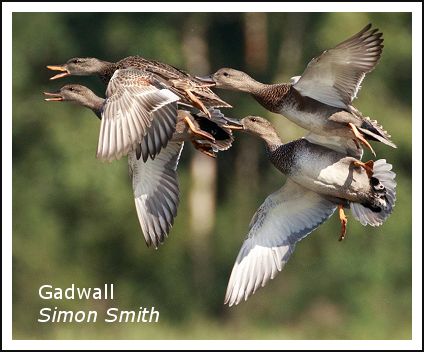 - blue skies, a scattering of clouds and 20C when a substantial group of 13 mid-weekers enjoyed a stroll around Woolston Eyes. - blue skies, a scattering of clouds and 20C when a substantial group of 13 mid-weekers enjoyed a stroll around Woolston Eyes.Wildfowl were keeping a low profile, only making an appearance when forced into the air by passing raptors; Shoveler, Mallard, Tufted Duck, Gadwall, Teal in a confusing mixture of plumages. We had good views of Snipe and the two Greenshanks that have been on the reserve for sometime now whilst the feeders were still quiet - Blue and Great Tits, a single Willow Tit and a few Greenfinches. Neumann's Flash has been in good form and, as Bob Groom's email illustrates, some nice birds have been turning up recently.... Called this morning. Blustery wind a bit unpleasant down at Pod's Hide but the birds were good. No spotted redshank or godwits but good views of the Wood Sandpiper, also 4 Curlews, to the right, while to the left (and left of the Lapwings) were 3 Little Ringed Plovers, 3 Dunlins and the Little Stint. There were at least 30 Pied Wagtails and half-a-dozen House Martins, swooping very low over the water.. A Kestrel the only raptor (strangely no buzzard seen). I Was lucky enough to catch the Whinchat on the fence at Ashton's Flash, before it disappeared into the vegetation. This Saturday (15th September) we have our field trip over to North Wales, we'll be leaving Lilac Avenue at 08:30am and meeting up around 10:00am at Llanfairfechan. The plan is to walk from the car park down to the Morfa Madryn reserve in the morning and then move on to the RSPB's Conwy Reserve in the afternoon.
We spent a very pleasant couple of hours last Tuesday (28th August) at Bob's Hobby nest site a few miles outside Knutsford where the birds are now more obvious as the chicks have recently fledged. 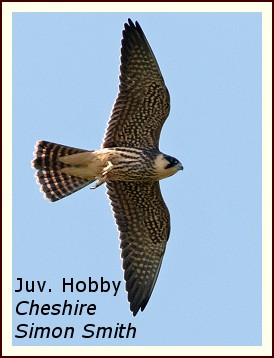 Having been to this location before we took the precaution of taking along folding picnic style seats in anticipation of long periods of inactivity between feeds! Having been to this location before we took the precaution of taking along folding picnic style seats in anticipation of long periods of inactivity between feeds!In the event we had arrived at just the right time and before we had chance to set the chairs up a sudden kerfuffle announced the arrival of the adult male carrying prey which was skillfully passed to what we assumed was the female of the pair who vanished into an oak tree pursued by two juveniles calling loudly. So, four birds in the air at the same time, this was a real bonus and a quite a surprise to Bob as previously he'd only seen three birds at any one time, including the previous day when Geoff and Sheila had visited the site. Geoff had taken a short video of two of the birds click here to view. As Sheila points out Geoff's video - seriously zoomed in hence the quality!. [High definition videos and other photographic files showing the barbs on individual feathers are ten-a-penny on the internet - for this, our own KOS website, I prefer record shots taken in the field by members showing the birds we actually saw - one day I'll put my famous picture of a Black Guillemot, taken in Burghead harbour in 1974 using a Balda 120 roll film folding camera, on the website!] On the Tuesday we enjoyed much better weather and witnessed one other visit by the male during the two hours we spent there - par for the course according to BWP. After the second the male was watched for some time as it climbed over the area. Higher and higher, until it was visible only through binoculars, pausing from time to time to take flying insects. Darren Morris has kindly sent me a copy of Tatton's excellent Autumn 2018 wildlife newsletter -click here- there's an opportunity again to accompany Fungal Punk Dave on one of his fungal forays - despite his name I believe he's very knowledgeable and you'll receive a good grounding in this often overlooked branch of our natural history. 23/08/2018...... Owls and other predators KOS members have been pretty active over the past couple of weeks, so plenty of catching up to do! A mystery bird in Mobberley variously described as a funny Buzzard or even an Eagle! 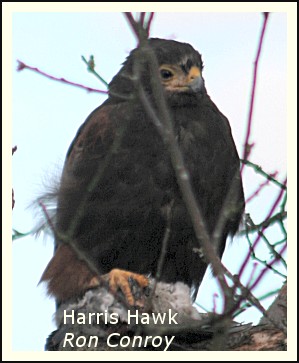 has been identified as an escaped Harris Hawk after it landed in the garden of Ron Conroy along Smith Lane. It had taken a Woodpigeon and remained long enough for Ron to obtain a quick record shot - thanks Ron. has been identified as an escaped Harris Hawk after it landed in the garden of Ron Conroy along Smith Lane. It had taken a Woodpigeon and remained long enough for Ron to obtain a quick record shot - thanks Ron.A nice surprise from Tatton Park where regular visitor Robert Purser recently found a Short Eared Owl close to the Mill Pond (7/8) - we have seen them previously at this location, but not normally until mid-winter and not very often! Geoff and Sheila Blamire also report a close encounter with a member of the Strix genus, in their back garden a short distance away in Mere - We were in the kitchen when we heard a loud noise above us about 2.45pm. We dashed outside and couldn't see anything, then I ran upstairs and looked out of our bedroom window and there was a Tawny Owl on our flat roof. I had arranged a mid-week outing to Neumann's flash yesterday (22nd) but due to circumstances beyond my control I couldn't go so I had to relinquish control to the Hon.Sec. who reports that everyone behaved themselves and they returned home with a nice total of 42 species.
14/08/2018......A poor year for Cheshire Hobbies
Hobbies were rarer than Buzzards even then and this has continued to the present day. I suspect their recovery has stalled over the past few years, even our "go to" 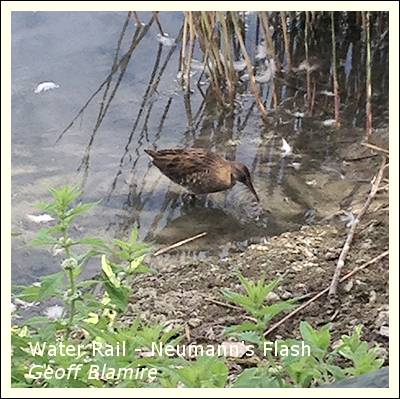 Hobby man Bob Groom has been struggling this year - the usual site a couple of miles from Knutsford has been unused, although he recently saw two birds at that particular location. When they were nesting in Mobberley we used to see them frequently, but nothing this time until a young bird was seen last week attacking Swallows at Dairy House farm on Church Lane. Hobby man Bob Groom has been struggling this year - the usual site a couple of miles from Knutsford has been unused, although he recently saw two birds at that particular location. When they were nesting in Mobberley we used to see them frequently, but nothing this time until a young bird was seen last week attacking Swallows at Dairy House farm on Church Lane.A species that seems to be prospering without any help is the Mediterranean Gull. On holiday in Newquay Wales, Roger Barnes noted these gulls over the village and further investigation revealed that a flock of no less than 720 were counted 9 miles up the coast at Llanon! - thanks Roger. We've not been over to the Northwich Flashes lately and perhaps a visit is overdue as there have been some good sightings lately. Bob has been there over the past couple of weeks as have Geoff and Sheila who've been building up their stamina for their next expedition! Fortunately they paused briefly at suitable locations and Sheila's email gives a flavour of what's been about..... We did our "usual" brisk walk around Neumann's Flash and on to Haydn Pool. Neumann's Flash. Spent some time in Pod's hide: to the right of the track - 1 juvenile Water Rail and 2 Reed Warblers all showing very well. From the hide - 1 Great White Egret, 1 Little Ringed Plover, 2 Dunlins, 1 Curlew, 2 Black-tailed Godwits, lots of Lapwings, loads of BH, several LBB and a few Common Gulls, 2nd Water Rail - again showing very well (lighter in colour to the 1st). At one time, it fed right in front of the hide for several minutes (Geoff took this photo on his phone - you can see how close it was!). So 4 species of waders and 3 species of gulls. Couldn't make out any Garganeys but from the larger hide a Common Sandpiper. Haydn Pool Just a couple of puddles but no sign of any Green Sandpipers. Peregrine on the tower and a Stock Dove was calling/singing.... 06/08/2018...... An offer you can't refuse! Nature's tide is turning as our Summer visitors slowly begin to drift south for the autumn and winter, just a bit early perhaps as the heat wave continues in the UK and temperature along their migration route over the Iberian peninsula reaches 47 ° C!! Visible migration is not always apparent in inland Cheshire but half an hour spent out of the sun early in the day revealed a steady passage of Swifts and Swallows, the Swifts will be the first to vanish, they're normally gone by the first week in September although perhaps they'll be a little later this year due to their late arrival this Spring. Signs on Wednesday morning (1/8) of the changing seasons over at Woolston Eyes where small numbers of Swifts and hirundines passed over and two Common Terns rested on a raft on the main lagoon alongside a Yellow Wagtail, whilst feeding in the shallows a few yards away, a Green Sandpiper, newly returned from the high Arctic. The reserve's Black-necked Grebes enjoyed a productive breeding season and have now dispersed leaving a motley collection of moulting wildfowl, although most of the regular species were represented, albeit in smaller numbers than we're used to seeing later in the year. Three species of raptor were noted with Buzzard, Sparrowhawk and Peregrine all joining a reasonable day list of 44. Tatton ranger Darren Morris, our window onto the hidden world of the park has suggested that KOS members might want to join him in a survey of the birdlife to be found in parts of Tatton not normally open to the public. It's early days yet but Darren proposes that the work takes place next Spring in April and May and will concentrate on a specific area that lies either side of a stream running through the park known as Hanging bank. The format of the survey will be a bespoke version of the Common Bird Census we do at Rostherne but a bit less complicated and shouldn't present problems for the average KOS member! This is a great opportunity to do a bit of real ornithology and you shouldn't let this offer pass you by!
The weather gods were kind to us and it wasn't until we were on our way home that the memorable spell of hot summer weather ended with the first substantial rain for some weeks. 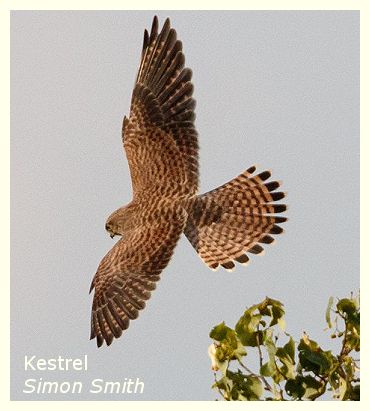 The reserve's volunteer wardens were our hosts for the evening - Phil, Steve, Chris, Dave and John who took us first to the obs. before we split into two groups - the first would make their way all the way around the mere the second enjoy a shorter walk through Wood Bongs and down to the new Bittern hide. The reserve's volunteer wardens were our hosts for the evening - Phil, Steve, Chris, Dave and John who took us first to the obs. before we split into two groups - the first would make their way all the way around the mere the second enjoy a shorter walk through Wood Bongs and down to the new Bittern hide. I joined Phil and Chris for the longer walk and my gps app showed it as being 3.3Km - not too far but slow going at times along the rarely used paths in Mere Covert, although we did speed up a little passing out of Harper's Bank wood into an open field occupied by a large bull with an alleged attitude problem! Given the time of year we weren't expecting to record many species so a final count of 40 was par for the course; from the obs. we had a Kestrel perched on the split lime and a dead tree just to the right held a small post-breeding flock of six Mistle Thrushes and a Green Woodpecker. For some members this was their first visit to the reserve and the obs. so I hope they're encouraged to obtain a permit (
£
10 p/a from Dave Clarke,1 Harts Avenue, Sale, M33 2JY.) in fact on Friday Dave was offering half price permits for the rest of the year - this offer could well have been extended! Rostherne's at it's most interesting in the Winter months so it was suggested we might pay a visit in January or February sometime in the future. That's something we can discuss at one of our committee meetings, in the mean time the reserve is open every day of the year - a good place to relax for a few hours whatever the season. away from the hustle and bustle of our usual busy haunts.
On Saturday (21st) a couple of us travelled up to Buxton where, as part of the Buxton International Festival, we attended presentations by two of the country's most well-known ornithologists - Mark Cocker and 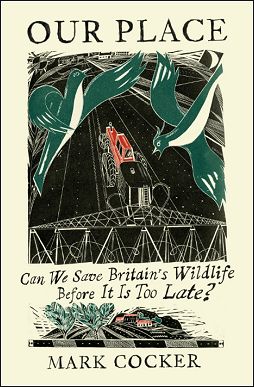 Tim Birkhead. Both have recently published new books and in sessions lasting for an hour each explained the reasons they chose the subjects and the extensive research required before they were able to put pen to paper. Tim Birkhead. Both have recently published new books and in sessions lasting for an hour each explained the reasons they chose the subjects and the extensive research required before they were able to put pen to paper. Mark was first up at 10am in the Pavilion Arts Centre and had attracted a large audience - I estimated at least 150 people were packed into the venue. I've yet to read his book "Our Place" but it deals with the British countryside and his pessimistic view of it's future, blaming current agricultural methods and the ineffective agencies, both government and non-government and their reluctance to deal with obvious deficiencies in our approach to conservation. I like the cover of his book (left) showing two Lapwings watching agricultural machinery trashing their nest site - shades of this year's Mobberley Lapwings. Tim Birkhead's talk was held in a smaller venue - the Spiegeltent, this too was well attended but I thought he could have done with the sort of microphone Mark had used and I think some people at the back were struggling to hear everything. I've seen Tim before at one of the CAWOS indoor meetings and he's good - very good! His presentation was based on his latest book - "The Wonderful Mr. Willughby" - Francis Willughby lived and thrived in the midst of the scientific revolution of the seventeenth century. Along with his Cambridge tutor John Ray, Willughby was determined to overhaul the whole of natural history and impose order on its complexity. Tim was helped by a small group of academics who's research he distilled down and combined with the discoveries he made after he made contact with Willugby's descendants (including the world's oldest authenticated birds egg collection!) I'd enjoy this lecture again if he returns to talk to CAWOS or even the KOS!! Despite the very hot weather and July not being the best time for birding a few members have been out and about; Geoff and Sheila Blamire saw a Great Egret at Neumann's Flash and four Green Sandpipers on Haydn's Pool, unusually Darren Morris also recorded a Green Sandpiper, on a small pool in Tatton Park's deer enclosure. Bob Groom reports Hobbies at two locations, but no evidence of breeding this year at their traditional site where he recorded a large flock of 60+ Swifts - they'll be leaving us soon and heading south. Please remember that on Friday this week (27th) we will be enjoying our third and final evening walk of the season, this will be to Rostherne Mere and a chance to have a look at the observatory and the new Bittern hide as well as the opportunity to walk all the way around the mere. We're meeting in the Natural England car park (half way down the main street opposite the Egerton Hall) at 6:30pm. 08/07/2018...... KOS trip to RSPB Burton Mere Wetlands At our annual KOS mid-January committee meeting we arrange the programme of outdoor events for the twelve months following the final trip of the current season. I'd printed out a calendar for 2018 / 2019 with the various statutory holidays marked so that they could be avoided, in passing I mentioned that Saturday 7th July, the date we had allocated for a day trip to Burton Mere, was World Cup quarter final day but as the odds of England reaching such dizzy heights were so 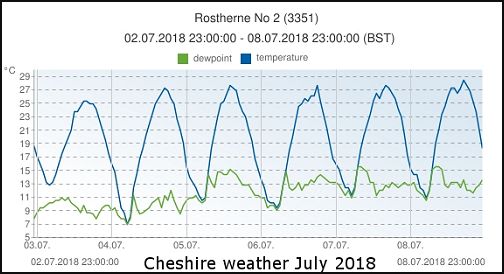 infinitesimally small we decided not to pencil in the 8th instead....... The best laid schemes of mice and men! infinitesimally small we decided not to pencil in the 8th instead....... The best laid schemes of mice and men!The trip went ahead of course, and we simply left for home a little earlier than normal, so ensuring that we'd not miss the kick off at 3pm. An early start at 08:30am from Lilac Avenue got us to the reserve at 09:15; it was yet another beautiful morning as the long-lasting spell of hot weather continued, already 21
°
C at 9am rising to 26
°
C by 1pm, but a steady breeze from the Dee estuary made for perfect conditions. The reception building opened at 9:30am and we set up shop overlooking the main lagoon, some of us enjoying a welcome cup of RSPB filter coffee (
£
1:80 a cup) - very civilised. How did the match go? Well the Swedes did the gentlemanly thing and folded like a pack of IKEA furniture leaving us with a semi-final against the Croats who limped off the pitch after a penalty shootout with Novichok United, so it looks like the first World Cup final since Jimmy Wood was landlord at the Bull's Head against our friends from Belgium ..... the best laid schemes of mice and men!
I estimate that Jude Halman and I each spent a total of over 24 hours during the Spring doing the CBC survey in Harper's Bank Wood at Rostherne, other volunteers probably matched this and, like us, 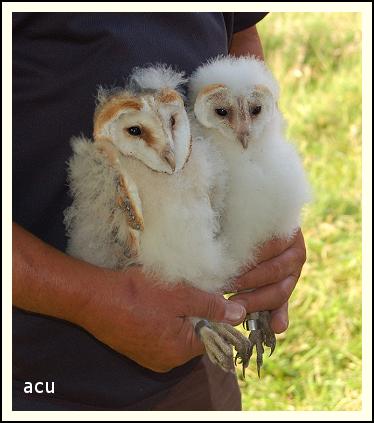 experienced a whole range of weather conditions - from icy, incessant rain in early April to pleasant, warm days towards the end of May. It was a nice surprise (perhaps in recognition of our endeavours!) that arrangements had been made for those concerned to participate in the ringing of the reserve's two broods of Barn Owl chicks on Monday evening (25th). experienced a whole range of weather conditions - from icy, incessant rain in early April to pleasant, warm days towards the end of May. It was a nice surprise (perhaps in recognition of our endeavours!) that arrangements had been made for those concerned to participate in the ringing of the reserve's two broods of Barn Owl chicks on Monday evening (25th).The operation was carried out under the supervision of Hugh Pulsford of the South Manchester Ringing Group and a senior member of one of the local Barn Owl groups (sorry but I didn't catch his name), the actual ringing was done by three trainees who completed the task quickly and without any mishaps before each bird was weighed, had it's wing length measured and, where possible, sexed. 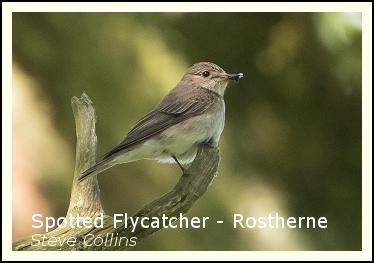 It was a great experience and the running commentary by Hugh added to the enjoyment of the occasion, it would be nice if this sort of activity was made available to a bigger audience - not just committed birdwatchers but perhaps also to younger people, I suspect it would fire their enthusiasm and imaginations more than the usual pond dipping and bug house construction! It was a great experience and the running commentary by Hugh added to the enjoyment of the occasion, it would be nice if this sort of activity was made available to a bigger audience - not just committed birdwatchers but perhaps also to younger people, I suspect it would fire their enthusiasm and imaginations more than the usual pond dipping and bug house construction!On our way back from the nests we passed through Wood Bongs where Steve Collins had been carrying out the CBC survey, he'd finally located the nest site of the Spotted Flycatchers and we had good views of the birds - unfortunately I don't think they'll still be around next month when we have the third KOS Friday evening walk which will be around the Rostherne reserve. KOS members Ken and Shirley Davies have continued their post retirement travels this time to Iceland and the Faroe Islands via Sweden. Shirley and myself started out in our motor home for Harwich on the 30th April. We took the ferry to the Hook of Holland over night, weather not so good for the first few days and after that only 4 days rain until arriving home on the 15th June (2,879 miles) after travelling through Holland, Germany, Denmark, Sweden. 24/6/2018...... Mobberley Perfect conditions with blue sky and a temperature of 20 ° C for the second of this year's evening walks on Friday (22nd), a gentle 4.7Km stroll around the fields of Mobberley; 17 members gathered in Mill Lane close to the Bull's Head before setting off promptly at 6:45pm to the sound of two Oystercatchers calling as they passed over - a good start to the evening's list. Left at the top of Beech Hill, 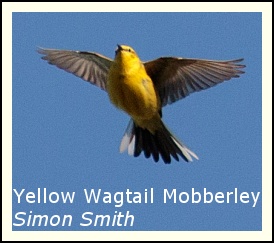 down the track next to Beech Cottage and out into the Mobberley hinterlands and places that the average Mobblonian doesn't know exist! down the track next to Beech Cottage and out into the Mobberley hinterlands and places that the average Mobblonian doesn't know exist!This is not the best time of the year for bird song but brief snatches from some species were enough to confirm their presence; Yellowhammers never let us down, they'll sing right through to September and one performing just past the cottage was the first of several we encountered. Halfway down to Fox harbour and we were delighted to hear and see two pairs of Yellow Wagtails that appear to be feeding young in the huge potato field to the left of the path. We've had them here in previous years and they should be ok as the spuds won't be lifted just yet. Skylarks were singing above the rough pasture leading down to Pedley Brook, no Sand Martins again this year but in the tangled vegetation alongside the brook - Common Whitethroat, Blackcap, Nuthatch and Chiffchaff went on the scorecard. The old bridge at the bottom of the driving lane up to Gleavehouse Farm 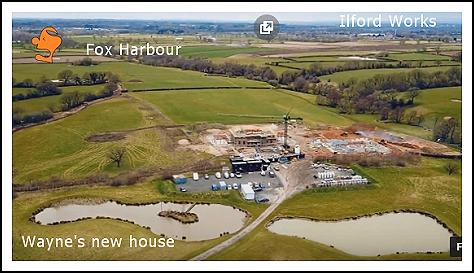 remains and allowed us to cross the brook and head up to the marl pit at the top of the valley. A singing Lesser Whitethroat was quite a surprise; they nested here two years ago but you don't normally hear them this late - perhaps having a second brood: top bird! remains and allowed us to cross the brook and head up to the marl pit at the top of the valley. A singing Lesser Whitethroat was quite a surprise; they nested here two years ago but you don't normally hear them this late - perhaps having a second brood: top bird! No Spotted Flycatchers at Springwood farm this time but Swallows are doing very nicely and at least 20, adults and juveniles, were lined up for our inspection on a convenient fence. On then to the top of Pavement Lane where a Little Owl was enjoying the last of the sun, sat in it's usual Oak tree just past Pavement Lane Farm, we went on to see two more along Gleavehouse Lane - one on the new metal farm building and the other just before the gates up to Wes's pad (now on the market at the much reduced price of £ 4.75M if you want to join us in Mobberley!!). Beyond Gleavehouse Farm, in the distance past the Yellow Wagtail field Wayne Rooney's new £ 20M mansion can be seen. Apparently it will include a library!! Just two more stiles and we arrived at Mobberley SQ, the original area of water has all but evaporated completely in the warm weather but the two new pools are still quite full and House Martins from their colony just across Town Lane fed over the surface. An excellent evening - great weather, some good birds and the usual agreeable company.
The Black-necked Grebes at Woolston Eyes have had a great breeding season, Brian Martin - Recorder of the Woolston Eyes Conservation Group told us yesterday (13th) that there were 14 adult and 16 juvenile birds on the reserve. It's not an easy job counting them so we took Brian's word for it! 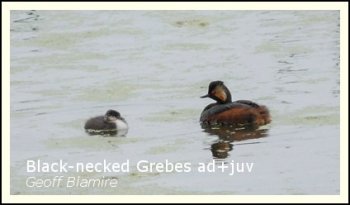 We watched a pair that appear to be planning a second brood, they were aggressively defending their new territory from the attentions of three or four others, probably unmated males. The pair have been seen copulating. Little and Great Crested Grebes also had young, as did a number of the other wildfowl species including Mallard, Coot, Pochard and Gadwall; the latter were present in huge numbers prior to their moult and period of flightlessness when they loose their wing feathers, no less than 318 had been counted the previous day. We watched a pair that appear to be planning a second brood, they were aggressively defending their new territory from the attentions of three or four others, probably unmated males. The pair have been seen copulating. Little and Great Crested Grebes also had young, as did a number of the other wildfowl species including Mallard, Coot, Pochard and Gadwall; the latter were present in huge numbers prior to their moult and period of flightlessness when they loose their wing feathers, no less than 318 had been counted the previous day. Reed Warblers, Wrens, Common Whitethroats and a few Blackcaps were still in song; a Peregrine  appeared for a short time circling over the reserve rapidly gaining height as it took advantage of a thermal generated on an increasingly warm day. Three Avocets had arrived in the early morning and stayed long enough for us to get good views from the Morgan hide, they're quite frequent visitors to Woolston and the local birders are hoping that eventually they'll remain and perhaps breed on the reserve. appeared for a short time circling over the reserve rapidly gaining height as it took advantage of a thermal generated on an increasingly warm day. Three Avocets had arrived in the early morning and stayed long enough for us to get good views from the Morgan hide, they're quite frequent visitors to Woolston and the local birders are hoping that eventually they'll remain and perhaps breed on the reserve.Our Mobberley Lapwings along Smith Lane seem to have failed completely again, last week only one incubating bird was present, along with a fox criss-crossing the field with it's nose to the ground. It's not all bad news of course and some birds have bred successfully - Bob Groom has been watching two pairs of Yellow Wagtails feeding young in Tabley, at Rostherne the Spotted Flycatchers are still around and we watched a well-grown young green Woodpecker peering from it's nest hole in an oak tree. As usual Geoff and Sheila's garden in Mere is the scene of much activity ....." Our garden is full of juveniles with their hard working parents. Some are: Great and Blue Tits, Goldfinches (for a long time), Chaffinches and perhaps Nuthatches. We still have 2 pairs of Greenfinches and Bullfinches - of course they take the seed to regurgitate to their youngsters, but they should appear in the garden soon. Even a House Sparrow juvenile with its parents, no idea where their nest was. We still have pair of Mallards (assuming their juvs were predated as last year) and 2 pairs of Woodpigeons. Then Carrion Crows, Jackdaws and Magpies - many juvs. - quite a racket! Then yesterday our first Great Spot. juvenile, with its mum. Have at least 2 females adults and 1 male adult Gt spot, so its only question when the other juveniles appear with their parents"..... The brothers Leigh - Roy and Paul (both products of our KOS junior section - those were the days!!) independently reported Red Kites at the same time flying over different parts of the county - Roy's at Northwich and Paul's over the Ilford works in Mobberley' it's only a matter of time before they become as common as Buzzards, as is the case now in many parts of Britain.Next Friday (22nd) it's the second of our Summer evening walks, this time around the fields of Mobberley meeting up on Mill Lane Mobberley (WA16 7HX) at 6:45pm. It should take about 2.5 hours, a bit rough in places but relatively dry - stout shoes but wellies not needed. In the past we've had Hobby, Curlew, Barn Owl, Little Owl, Yellow Wagtails and even a Whinchat - but none are guaranteed of course!
A decent enough morning on Saturday (2nd) for our June field trip to the Lancashire Wildlife Trust's excellent Brockholes reserve a short 45' drive north up the M6 motorway. 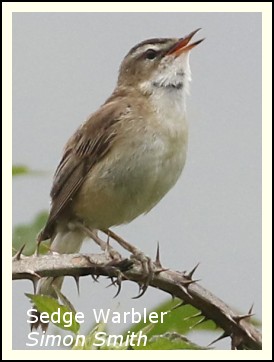 Quite cool at first with a very fine drizzle giving way to a dry day, overcast but with some sunny periods later. Quite cool at first with a very fine drizzle giving way to a dry day, overcast but with some sunny periods later.The early morning conditions seemed to suit the nesting warblers and there was plenty of song from Chiffchaffs, Common Whitethroats and Willow Warblers but without a doubt the star performers were the numerous Sedge Warblers singing from the dense rank undergrowth lining the footpaths for the first part of our walk around the perimeter of the reserve. They're less concerned by the presence of an audience than Reed Warblers and frequently took to the air in their display flight or, like the individual in Simon's excellent photo, perched out in the open for all to see; this bird was on top form and gave us his full repertoire - without hesitation, deviation or repetition! Our first port of call was "The Lookout", a glass fronted hide overlooking the imaginatively named Number One Pit - Sand Martins were using the artificial nesting banks provided for them and a Common Tern appeared to be nesting on a wooden raft anchored to the bed of the lake, a Common Sandpiper patrolled the shoreline whilst out in the middle of the lake three Common Scoters were an unexpected addition to the day list. On Monday (4th) Jude Halman and I completed our final visit to Rostherne's Harper's Bank Wood as part of the ongoing Common Bird Census. The other four areas covered will also be finished this week, the data will be analysed and in due course a report published, if it's allowable I'll add it to this website. The highlight for us was the Spotted Flycatcher we found, but it was only seen once - perhaps this is the bird that later turned up on Steve Collins' patch in Wood Bongs. Steve also reports a singing Grasshopper Warbler at Ashton's Flash close to the car park at Witton Mill - it can be heard from "the mound", we've had one at this location in previous years. The CBC type of survey that continues at Rostherne has now been largely replaced by the Breeding Bird Survey or BBS, a joint effort by the RSPB/JNCC/BTO based on 1 Km squares. Geoff and Sheila Blamire are volunteers and on Sunday (3rd) enjoyed a close encounter with a displaying Goldcrest!......"But the best was when we saw a pair of Goldcrests low down in a conifer next to the road. After a few minutes the male started to sing, raising its crest, and with the whole body shaking with the effort - and literally just 4 feet away!"
After the beautiful weather and plethora of species we enjoyed on our recent visit to Suffolk we were brought down to earth with a bump on Friday (25th) as we headed into the Pennines for the first of our three evening Summer walks. The whole day had been gloomy and when we drove out of Macclesfield up into the hills it became even darker as we climbed into the low cloud which had descended to about 600' [this is the climb on a good day!]. In the past visibility had sometimes improved when descending from Pym Chair down into the Goyt: but not on this occasion. We met up in the usual second car park 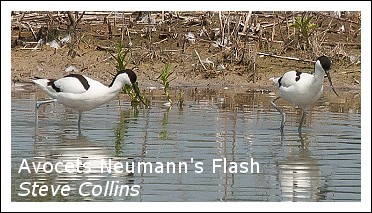 along the valley and, despite the weather, there was a reasonable turnout of about twelve members plus Richard and Bridget, two potential new members from Stretford (sorry about the weather folks but it's not like this all the time!) along the valley and, despite the weather, there was a reasonable turnout of about twelve members plus Richard and Bridget, two potential new members from Stretford (sorry about the weather folks but it's not like this all the time!)Two Willow Warblers sang as we set off and a Cuckoo called briefly in the distance (the first of the year for some who'd not ventured outside Cheshire so far) but it was soon obvious that we would be struggling to even reach double figures during the whole evening. Visibility was so poor that we could barely make out the opposite shore of the reservoir and as we stood next to the River Goyt there wasn't a bird to be heard, nevertheless it was decided to continue with plan "A" so it was back to the cars and a short drive away from the valley to a location where in the past two years we'd had both Woodcock and singing Nightjars. No Nightjars unfortunately but there were roding Woodcock, mostly unseen in the mist but they did loom into view from time to time and three shot past chasing each other at one point. We ended the night with a grand total of 11 species, an indication of how bad conditions were. I'm sure we'll do better than that this Saturday (26th) when we take the 45' drive up to Brockholes an interesting set up run by the Lancashire Wildlife Trust - it's easy walking with a range of routes and full facilities including a very nice cafe. 8:30am start from Lilac Avenue or alternatively 9:15 in the reserve car park. The car park opens at 06:30am and the visitor village at 10:30am. PR5 0AG Steve Collins has been over to Neumann's Flash again and reports Avocets, Ringed Plover and even a Turnstone - very rare inland - thanks Steve.
23/05/2018...... KOS Trip to Suffolk We'd hoped for a total of around 100 species during our recent long weekend in Suffolk, in the event we managed no less than 112! An excellent trip - good weather and as usual good company. Read all about it and enjoy Simon's brilliant images by clicking here Back in Cheshire we apparently missed a few rarities whilst we were away, Steve Collins updated me on our return "It's been a good week at Marbury with the White-winged Black Tern on the Mere and Greenshank and Avocet at Haydn's, and Great White Egret at Ashton's and Garganey on Neumann's!" On Monday (22nd) Jude Halman and I did the latest CBC morning survey at Rostherne Mere where, amongst the usual Wrens, Robins and Blue Tits in Harper's Bank Wood we were delighted to record a Spotted Flycatcher. A pair nested last year in Wood Bongs - the first recorded breeding on the reserve since 1989! Let's hope this year's bird finds a mate and continues the tradition. Don't forget this coming Friday (25th) it's the first of our three Summer evening walks. We're off to the Goyt again and hope to catch up with the displaying Woodcock and other crepuscular species! 6:30pm at the Tatton Street car park in Knutsford or 7:30pm at the middle car park in the valley. We'll be there until late again so it's always advisable to take a torch along. 15/5/2018...... Lapwings try again
I counted eight birds, four appeared to be incubating and their partners were busy seeing off inquisitive corvids, lets hope they're now left alone to complete the breeding cycle. I received an email last week from John Chrystal who told me he'd been watching a pair of Yellow Wagtails carrying food to what was presumably a well hidden nest on the west side of Knutsford. John tells me they were quite common until the mid-nineties, but since then they've declined considerably so he was pleased to find this pair - thanks John. This is another species that we too have recorded on fewer and fewer occasions; I remember in the 1970's sitting by the side of Tatton Mere in the early evening and counting 56 migrating Yellow Wagtails leave the cover of the small Alder tree that still grows close to the old bathing area. I don't recall any being seen in the park in recent years. I spent Monday morning doing this week's common bird census (CBC) in Rostherne NNR's Harper's Bank Wood, a pleasant 15 ° C by the time I finished at lunch time. This survey work on the reserve has been going on now for over 50 years and provides invaluable data that helps to provide a good indication of the broad state of wildlife in Cheshire. This is because our birds occupy a wide range of habitats and respond to environmental pressures that also operate on other groups of wildlife. The work lasts about 10 weeks between the beginning of April to the end of May - one visit per week lasting about three hours. Participants get to see areas of the reserve not open to the public, including the new Bittern Hide - it's not too demanding and help is always available for anyone doing this sort of thing for the first time. On Thursday we head south for a long weekend's birding in Suffolk based at the Thetford Premier Inn, the weather forecast is good and I'm told we should be aiming for a list of 100 species - we'll see!! 11/05/2018...... The Goyt Valley Prior to our mid-week visit to the Goyt Valley on Wednesday (9th), as a bit of a challenge to the troops, I compiled a list of a dozen species we might find (in probability order) -  Willow Warbler, Chiffchaff, Blackcap, Tree Pipit, Common Sandpiper, Redstart, Curlew, Pied Flycatcher, Spotted Flycatcher, Wood Warbler, Cuckoo, Hen Harrier. We managed a creditable eight of these amongst a modest final tally of 39 species including a nice bonus at the end of the day. Willow Warbler, Chiffchaff, Blackcap, Tree Pipit, Common Sandpiper, Redstart, Curlew, Pied Flycatcher, Spotted Flycatcher, Wood Warbler, Cuckoo, Hen Harrier. We managed a creditable eight of these amongst a modest final tally of 39 species including a nice bonus at the end of the day.We were lucky with the weather - blue sky and a temperature of 15 ° C, quite cool but pleasant enough in the shelter of the valley. We parked in the usual second car park before starting off up the steep slope to the rough path that runs parallel with the road - by the time we'd 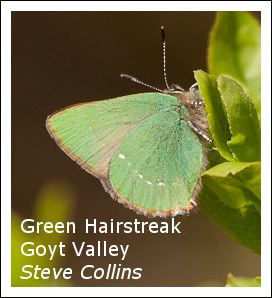 reached the top of the slope five of my list had already been ticked off - Willow Warbler, Chiffchaff, Tree Pipit, Redstart and Pied Flycatcher! The birds were very active with a confusion of song - it's not easy when you've not heard them since last year! In addition this time there were a lot more Goldfinches than we'd had in previous years, they really have increased in numbers everywhere. We've noticed it locally with the species now very common, even in the heart of Tatton's Dog Wood. reached the top of the slope five of my list had already been ticked off - Willow Warbler, Chiffchaff, Tree Pipit, Redstart and Pied Flycatcher! The birds were very active with a confusion of song - it's not easy when you've not heard them since last year! In addition this time there were a lot more Goldfinches than we'd had in previous years, they really have increased in numbers everywhere. We've noticed it locally with the species now very common, even in the heart of Tatton's Dog Wood.Single Redpolls and Siskins were noted as we walked back to the road and along as far as the steep steps down to the River Goyt where we had our elevenses and enjoyed views of both Dipper and Grey Wagtails. More Pied Flycatchers, Tree Pipits and a pair of Redstarts on the return stroll back to the cars; all three species were considered more numerous this year than in 2017, Curlews called but we didn't actually see any and a Common Sandpiper flew low over the river and across the reservoir which looked to be filled to capacity after such a wet Winter. A local birder we talked to said we may have been a tad optimistic putting Spotted Flycatcher and Wood Warbler on the list and thought it was still early for those species along the Goyt, perhaps we'll have more luck in a couple of weeks when we return on the first of our KOS Summer 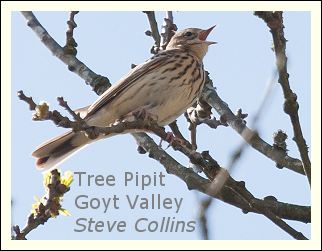 evening walks (25th). evening walks (25th).Our second stop of the day, before returning home, was at the eastern end of the valley at Derbyshire Bridge where Blackbird was added to the list and a pair of Red Grouse flying quickly over inevitably led to a discussion about the ridiculous price of cup final tickets! Some years ago we'd had a pair of Whinchats just up the road, towards the "Cat and Fiddle" but despite repeated visits we'd been unlucky in subsequent years, nevertheless we gave it another coat of looking at this year - and yes that's right - there they were in exactly the same place, a pair of Whinchats! They were quite active commuting from post to post and down into the heather unconcerned by our presence - excellent and a nice way to end our morning up in the Pennines. Some news from Mobberley and the all white Robin that was seen last year in the area around Mill Lane has re-appeared in the garden of Barbara and Alan Langston - it's done well to last so long. Thanks Alan. The fields opposite Smith Lane farm with newly hatched Lapwings mentioned in the last update (1/5/2018) has had visitors. They've been ploughed up and last week a contraption like a cross between a WW1 tank and something out of a Mad Max movie was going over it again! All I can do is record what has happened and, as I know little about farming, I'm not in any position to offer advice or constructive criticism to the parties involved, but it does seem a shame and such a blow to a threatened species like the Lapwing. As we were making our way back to the cars we met Sue George from Leek in Staffordshire who'd been lucky enough to come across the Woodcock pictured below and she kindly sent the image on to us for use on our website. We're hoping to watch this species displaying on our forthcoming trip, but I don't think we'll get this close to one - well done Sue and many thanks!
Our KOS AGM last Friday (27th April) went very well with 26 members and 2 visitors present - 70% attendance, not many organisations do as well as that! The formalities took only ten minutes before part two of the evening, a very professional presentation by our Hon. Chairman Sheila Blamire (ably assisted by Geoff of course) entitled "Panama, the Land of the Harpy Eagle", an account of their very strenuous and ultimately successful expedition to Central America in search of that iconic denizen of the rain forests. A little closer to We're now at just about the peak time for the Spring migration and members will be looking for Terns over Tatton Mere and their first local Garden Warblers and Flycatchers of the season etc in and around Dog Wood. Simon and Lyn have already visited the Goyt Valley where they had both Pied Flycatchers and Tree Pipits; we have a trip there on the evening Friday 25th May when we return from the Suffolk long weekend, but it may be a good idea to have a look before then and catch the valley's specialities whilst they're in full song. Some species already have chicks, at least four pairs of Herons are feeding well grown youngsters in the Higmere colony opposite Dog Wood, in Mobberley our Blackbirds have been successful and Starlings are finding plenty of food for their offsprings in the boggy area around Mobberley SQ, where the first family of Mallard ducklings appeared this week. Also in Mobberley, Lapwings are doing well in the big fields opposite Smith Lane Farm and at least one pair had chicks when I investigated on Sunday (29th April) - I hope they can vacate the area before the farmer does anymore work on the fields. Members who attended the AGM last Friday will have been given a copy of the 2018 - 2019 KOS programme. Those not in attendance (or anyone else for that matter) can download a copy by clicking here Members who haven't yet read their copy of the May 2018 edition of "British Birds" may be interested to know that this website features quite prominently in the 10 page paper by Jeremy and Julian Greenwood entitled " The origin of the birdwatching term "jizz"". Contrary to the belief in certain quarters we do sometimes take our birding quite seriously! 25/04/2018...... The first airport walk of the year Heavy overnight rain had left the usual walking routes around the perimeter of Runway 2 very slutchy or as they say nowadays - "challenging"! The weather had moderated by the early morning and it was quite pleasant as we set off from Crashgate 9, our usual starting point for these mid-week outings, 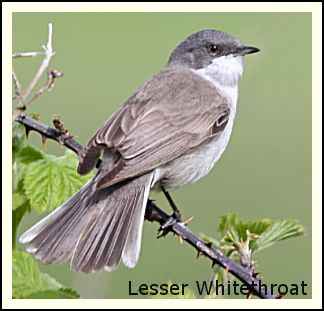 a Song Thrush was singing beautifully from the top of an ash tree next to where the cars were parked - it's nice to see and hear so many about this Spring as they had seemed to be struggling somewhat in the past few years. a Song Thrush was singing beautifully from the top of an ash tree next to where the cars were parked - it's nice to see and hear so many about this Spring as they had seemed to be struggling somewhat in the past few years. We'd only gone a short distance before the first of our hoped for species was detected - a fine little Common Whitethroat singing from a tangle of trackside vegetation; hidden at first but eventually it showed well for our little group as it flew to the top of a hawthorn bush. Further along the bridleway the first Chiffchaffs and Blackcaps of the day were in song; in the farm at the end of Ostler's Lane newly arrived House Martins and Swallows chased each other around the buildings. From here we made our way carefully along the muddy footpath until it came out onto Woodend Lane, with the benefit of hindsight it would have been better to keep to the road as the route we took, on this occasion, was pretty difficult. Still we had some good birds for the day list - Green and Great Spotted Woodpeckers and a singing Lesser Whitethroat that gave good (if rather fleeting) views as it moved through the dense foliage. Learn the song and you'll be surprised how many there are in our Cheshire hedgerows! Leaving Woodend Lane we proceeded along the slightly less muddy track down towards the River Bollin, Skylarks hung in the air over the airfield oblivious to the jets only yards away as they thundered along R2 and briefly, from somewhere in the distance, we just caught the call of a Curlew - along with Snipe they used to nest in the village but those days seem to be long gone. From just before the drop down to the Bollin you get wide-ranging views across the Cheshire plain and we could see some ominous weather approaching, as we entered the tunnel under R2 it began to rain. Dry in the tunnel of course as we enjoyed elevenses before turning left at the far end ready to tackle the steep, very steep road back up the side of the valley. Our Hon. Chairman likes to run up it but the rest of us are a little more cautious! The general consensus is that if you can get to the top without stopping then you're probably good for another 12 months! Just a few more species on the return leg of the walk and we ended up with a modest total of 38 as reward for our exertions - nothing exceptional but some good views of those we came across. Bob Groom's been out and about again, including a trip over to Burton Mere - Wood Warbler and Fieldfare in the same tree near Burton Mere car park this morning! Lots of good birds on the Reserve, including many Avocets, 7 Spotted Redshanks, associating with a big flock of Black-Tailed Godwits, also a single Ruff plus 2 Mediterranean Gull, 1 Great White Egret, Cetti's Warbler (super view), Reed Warbler. Also one of the many Blackcaps did a whole series of imitations, completely different to its normal song, and we watched it doing them so no mistake about the ID of the songster, completely new to me. Raptors were in short supply, just Buzzard and Kestrel. Sounds good Bob, the reserve goes from strength to strength and I think we might consider paying a visit sooner rather that later. Don't forget it's our KOS AGM this coming Friday (27th) in the Jubilee Hall at 8pm. All the current officers will be standing again so no need to worry about being press-ganged into something you don't fancy! It will take about 10 minutes if previous years are anything to go by. After this formality Geoff and Sheila Blamire will be telling us all about their recent trip to Central America - " Panama, The Land of the Harpy Eagle"
A pleasant Spring day on Saturday (14th) for the first of two days birding in North Wales, we began at Llanfairfechan and walked along the seafront as far as the Morfa Madryn reserve. The tide was coming in as we walked the mile or so to the hides, out on the sea the 'scopes revealed Great Crested Grebes, Red-throated Divers 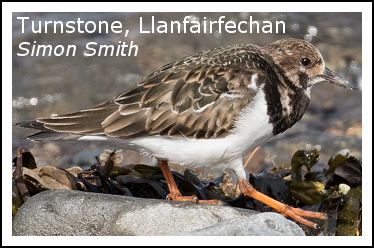 and Red-breasted Mergansers whilst a flock of 20 Turnstones, just a few yards out from the sea wall but almost invisible to the naked eye sat out the incoming tide, camouflaged perfectly against the piles of seaweed and sea-washed stones. and Red-breasted Mergansers whilst a flock of 20 Turnstones, just a few yards out from the sea wall but almost invisible to the naked eye sat out the incoming tide, camouflaged perfectly against the piles of seaweed and sea-washed stones.White Wagtails, pausing on their journey north up to Iceland, Faroe Islands and even the east coast of Greenland mixed in with our resident Pied Wagtails by the boating lake causing not a little head-scratching, but at this time of the year the male whites can be identified with some certainty. Other Summer 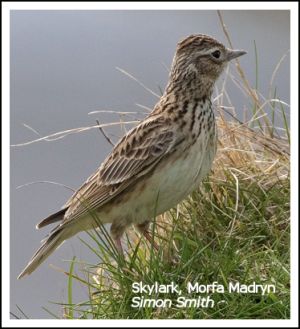 migrants were added to the list as we made our way along - Chiffchaff, Swallow and a number of Wheatears with a singing Willow Warbler actually on the Morfa Madryn reserve. An obliging Skylark posed nicely in excellent light for binoculars, 'scopes and cameras. migrants were added to the list as we made our way along - Chiffchaff, Swallow and a number of Wheatears with a singing Willow Warbler actually on the Morfa Madryn reserve. An obliging Skylark posed nicely in excellent light for binoculars, 'scopes and cameras. A brown smudge on a spit reaching out into the sea proved to be a large flock of roosting Curlews once the optics were focussed on them. The pools on the reserve held a good selection of species with Little Egret, Wigeon, Ringed Plover and a single Green Sandpiper recorded - further out, flying along the Menai Strait, a flock of Common Scoters headed out towards the open sea as the tide began to recede. The cafe back in Llanfairfechan was very busy when we returned so we returned down the A55 to the RSPB reserve at Conwy - only a short drive of about 10 minutes where we enjoyed lunch in the excellent little cafe - ok the service is a bit slow at times, but remember Some of our party stayed overnight at the Premier Inn in Glan-Conwy allowing a relaxed start to the day on Sunday. After an excellent breakfast we enjoyed a leisurely drive up the Marine Drive to the top of the Great Orme (first left after the Rest and be Thankful cafe) and by 10:15am we were on our way across the limestone pavement. Back down to Conwy for a late lunch before re-visiting the hides closest to the information centre where we added a couple of new species bringing our total for the trip to a creditable 71 before heading back down the busy A55 and M56 to Cheshire after a very enjoyable weekend break. Don't forget that this Friday (20th) it's the CAWOS (Cheshire and Wirral Ornithological Society's) re-arranged AGM at 7:45pm in St. Vincent's Church, Tatton Street, Knutsford. Followed by a presentation by Mike Roberts entitled "Wildlife and Birding in the Isle of Avalon". Admission is free. Late news today (17th April) A Lesser Whitethroat was singing this morning along Smith Lane in Mobberley.
There's been a gradual improvement in the weather over the past week or so. Last Monday (2nd April) Jude Halman and I completed the first of 10 weekly visits to Rostherne Mere to take part in the long-running CBC (common bird census). 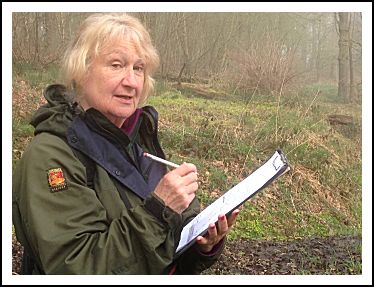 We have been allocated Harper's Bank Wood, a 300 meter stretch of mixed woodland running up from the mereside and it's Cormorant colony as far as the surrounding farm land with extensive views across the reserve. It was a challenging start to the season, incessant rain and the temperature never rose above 2.5
°
C - soggy paperwork (and participants)! We have been allocated Harper's Bank Wood, a 300 meter stretch of mixed woodland running up from the mereside and it's Cormorant colony as far as the surrounding farm land with extensive views across the reserve. It was a challenging start to the season, incessant rain and the temperature never rose above 2.5
°
C - soggy paperwork (and participants)!Yesterday the weather was much kinder, dry and sunny and a temperature of 12 ° C - singing Chiffchaffs and our first Blackcaps and Willow Warblers of the year. So, from the 2nd, things improved and our Summer visitors began to appear - on Wednesday (4th) Bob Groom had four Swallows and a migrating Osprey over Budworth Mere (incidentally the Dyfi Ospreys are back and the HD images from the nestcam are amazing - click here. It's well worth having a look and listen in the early evening when the Snipe can be heard calling and drumming). CAWOS members will have received their copy of the Cheshire and Wirral bird report for 2015 this week, 150 pages of facts and figures plus a selection of images of some of the rarities involved. In this age of instant news and views via the internet it may appear an antiquated way to disseminate information about the county's birds but of course this is not so. Stuff floating about in cyberspace is unchecked, unverified and can vanish forever in the blink of an eye! These publications will be around long after we've gone and will prove invaluable to future generations, so the fact that the latest report is a little late is irrelevant - all records are checked and verified making it a publication to be trusted. The amount of work done by those responsible for the report (all volunteers, including four KOS members) is quite amazing and our thanks are due to all concerned. 03/04/2018...... Bob's trip to the Canary IslandsBob Groom enjoyed a return trip to the Canary Islands in March. I've put his excellent report on a separate page - [click here] 29/03/2018...... In search of Summer migrants A good turnout of 12 mid-weekers yesterday (28th) for our first Springtime trip this season across to Woolston Eyes, some of the group were hoping for their first Summer migrant! This time last year we had 3 or 4 Chiffchaffs 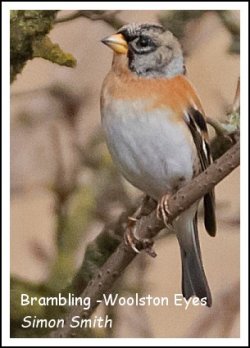 in song at Woolston, non were heard yesterday, but help was at hand later in the Morgan hide from where we had good views of first one, then later, two or three Sand Martins flying low over the surface of number three bed. in song at Woolston, non were heard yesterday, but help was at hand later in the Morgan hide from where we had good views of first one, then later, two or three Sand Martins flying low over the surface of number three bed.As we were watching these birds I received a text from Darren Morris in Tatton Park reporting a number of Sand Martins over Tatton Mere; Bob Groom paid a visit to the park later in the day and counted 16 birds. An early pair of Black-necked Grebes had returned to Woolston last week and were seen mating and nest building but unfortunately there was no sign of them yesterday. By way of compensation we did see two full Summer plumage Mediterranean Gulls amongst the hoards of Black-headed Gulls who were noisily squabbling over the best nest sites. So, no Black-necked Grebes yesterday but plenty of other water birds including - Mute Swan, Coot, Great Crested Grebe, Little Grebe, Mallard, Gadwall, Shelduck, Canada Goose, Greylag Goose, Shoveler, Moorhen, Pochard, Teal, all these species nest every year or have nested in the past so there was plenty going on in front of the hides. The feeders were still busy and we had excellent views of Greenfinches, Bramblings, Chaffinches and Bullfinches actually on the feeders with other less agile species below feeding on the discarded seeds. We had an interesting journey home as, for the first time, we were forced to stop and wait at the swing bridge on the A50 to allow a liquid gas tanker - the "Happy Falcon" to pass up the ship canal to Cadishead. Some people say it's illogical to import gas from abroad when we have 1,300 trillion cubic feet of shale gas lying beneath our feet!!
Things seem to be a bit late this year with just a scattering of Summer migrants appearing so far. We may have to wait a little longer too, with another spell of colder weather forecast for the coming Easter weekend. I spent a productive few hours yesterday morning (26th) in Tatton Park walking from Knutsford Moor, through Dog Wood and up to the bathing area before returning along the same route. There was much activity on the back pools of the Moor with noisy Canada Geese arguing over the same bit of prime real estate, a pair of Great Crested Grebes nest building just a few yards away and the whinnying call of a pair of Little Grebes revealed their presence, also at the same location. Further along a Chiffchaff was in full song, obviously enjoying the blue skies and "warmish" weather; it wasn't my first of the season, I'd had two in Mobberley last Tuesday (20th). There were plenty of Winter visitors still with us of course, six Goldeneye on Tatton Mere (4 males) and a mixed flock of Siskins and Redpolls fed in the Alder trees on the edge of the Moor. At least two Great Spotted Woodpeckers were drumming in Dog Wood where Goldcrests, Blue, Coal and Great Tits were all in song. 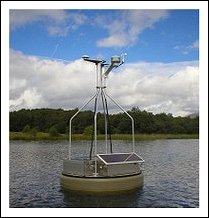 It was pretty chilly sat on the seat above the bathing area, no further Sand Martins but some visible migration with a steady passage of Lesser Black-backed Gulls heading north throughout the morning. It was pretty chilly sat on the seat above the bathing area, no further Sand Martins but some visible migration with a steady passage of Lesser Black-backed Gulls heading north throughout the morning.As I was leaving I met up with Andrew Judd who pointed me in the direction of the Redpolls and Siskins, he also told me he'd seen a Red Kite over the Moor last Saturday (24th). Elsewhere Bob Groom had an immature Kittiwake on Marbury Mere on Friday 23rd, a good record - we've had a few on Tatton over the years. Visitors to the Rostherne NNR may have wondered what was the purpose of the weather station floating on a buoy in the centre of the mere. I thought it may have provided the data used by the Met. Office who quote figures from Rostherne No.2 but that's not the case, Rostherne No.2 is located on nearby farm land to the north of the reserve. The station on the mere is part of network of similar set ups that are used to monitor lakes across the UK Click here and the data generated are available for free online click here. They are downloadable, so anyone who so wishes can do so and correlate the arrival and departure of avian migrants with the wind direction, temperature and sunshine etc. So get your spreadsheets out and off you go!!
Considering the weather forecast we had a surprisingly good turnout of nine hardy members for our March field trip up to Leighton Moss, we experienced three seasons during the course of the day - each one a number of times as weather systems came and went; a few brief interludes of warm Spring sunshine would be followed by autumnal gales bringing 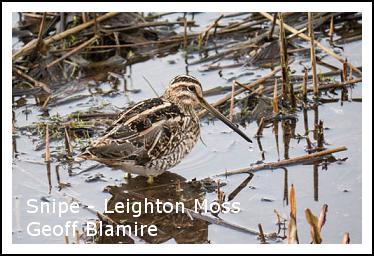 Winter blizzards of horizontal snow! Plenty of hides though and we managed a creditable final total of 66 species including excellent views of some of the less common of those on offer. Winter blizzards of horizontal snow! Plenty of hides though and we managed a creditable final total of 66 species including excellent views of some of the less common of those on offer.The day list began as we approached Leighton Moss from Carnforth driving alongside the new areas of reed that, I believe, now form part of the reserve - a Kingfisher flew across the road in front of us #1 and a good start; we'd reached 15 species before leaving the car park! The staff in the reception building were very helpful (a feature at Leighton Moss) with the latest news and there's always an up-to-date list on the white board next to the rear door onto the reserve. The expected range of species fed on and beneath the feeders - Great and Blue Tits, Nuthatch and Chaffinch although there was no sign of the Marsh Tits; a reserve speciality of course. Bitterns had been booming apparently but we didn't see or hear any during the day although a very vocal Water rail was squealing loudly as we walked down to the Tim Jackson hide. Plenty of species on view from the Jackson hide - Teal, Wigeon, Gadwall, Oystercatcher, Shoveler, Pintail, Little Egret and a female / juvenile Marsh harrier carrying a green wing tag. Two Snipe flew in, landing on a small reed covered island, there were quite a few around including one just next to the hide that posed nicely for Geoff's camera. Lunch was taken in the cars or in the reserve's excellent cafe before driving over to the two coastal hides - the Allen hide and the Eric Morecambe hide. Here we found a large flock of 106 Black-tailed Godwits and 20+ Avocets - superb birds! An electric fence has been erected around the Allen pool to deter predators which decimate the Avocets that attempt to breed there every year. Once again a website devoted to the Avocet's progress is again online [click here] let's hope the fence works and they have more success in 2018 than in previous years. Before returning to the cars for the journey back to Cheshire we paused near an anonymous looking clump of bushes where Barry Jordan had watched a Merlin attacking small passerines that were attracted to the area, there were Tits, Chaffinches and Reed Buntings aplenty; we concluded that food for the small birds must be provided at that particular spot for some reason. Remember this coming Friday - 23rd it's our March indoor meeting when Dr. Kevin Briggs will be giving a presentation entitled " Goosanders and Ringed Plovers" I think it's about the birds of the Lune Valley.
I knew Darren Morris was going into Tatton this morning looking for the year's first Sand Martin (the 14th March is the average arrival date) but as I'd not received a text by 1pm I thought that the cool conditions (11 ° C) meant that we'd just have to wait a little longer for the first of our Summer migrants to show up. 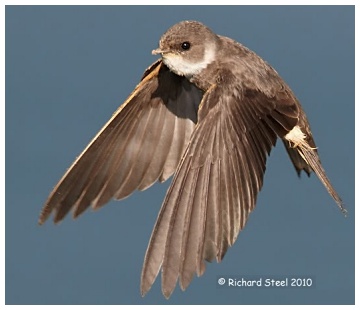 Nevertheless I decided to give it a try and lo and behold one appeared at 2:45pm, it wasn't flying low over the surface of the main mere as is usual, but passed almost directly overhead heading south. This was also the direction favoured by small groups of Lesser Black-backed Gulls that were moving through all the time I was in the park - perhaps they know something we don't! An email from Bob Groom tells me that there were three Sand Martins over Budworth Mere this morning and Wheatears have been seen on the Wirral, so with a bit of luck we'll have both species on our KOS trip to Leighton Moss this coming Saturday. Also in Tatton, Great Spotted Woodpeckers were noisily chasing each other through Dog Wood and across the other side of the mere, in Higmere plantation, I counted at least six Heron nests, three of which appeared to be occupied; a Cormorant perched at the top of one of Higmere's highest trees - perhaps they will start a new colony if Rostherne's has reached saturation point. Elsewhere in the park Derek and Jean report a female Goosander and Kingfisher at Melchett Mere plus a "yaffling" Green Woodpecker on the 8th March whilst Steve Scrimgeour had a Merlin chasing Goldfinches over Knutsford Moor on 27th February. Elsewhere Derek had 55-60 Lapwings and at least 4 Snipe on the big fields opposite the junction of Lilac Avenue and Northwich road, the Snipe were the first he'd seen there; I had a dozen feeding in a ditch along Pavement Lane in Mobberley during the recent cold weather and on the 8th a fine male Stonechat at the same location - a rare visitor in the village. Our Hon. Chairperson and Geoffrey had a hat trick of sightings on the 7th at Marbury......... We went to Marbury today to try for the Hawfinches (3rd attempt).
There were quite a lot of birders, including 3 in the "usual" spot. 07/03/2018...... Cold spell encourages garden visitors As predicted the "beast from the east" spread it's icy tentacles right across the British Isles over the past week, bringing sub-zero temperatures and heavy snow showers to all areas. Here on the Cheshire plain we avoided the worst of the snow but it was certainly cold with a minimum of -7.5 ° C at 7am on the last day of the month, whilst the following day (1st March and the first day of Spring) the maximum was only -1.2 ° C ! Unperturbed by the prevailing conditions Geoff and Sheila Blamire enjoyed an invigorating walk around Mere and Tabley on the 28th, taking in what I assume was the A556 but is now the B5569 which has been "de-trunked" as part of the new A556 link between the M6 and M56. This morning we decided to repeat a walk we did a few days ago. The sun quickly disappeared and we almost wished we hadn't bothered. The walk starts going along Moss Lane and the fields to the left were full of birds (we took our bins with us!). This is probably conservative estimate: The previous day they'd been over to Marbury in search of the Hawfinches. Went to Marbury CP Tuesday morning (briefly) to look for the Hawfinches - dipped again. 11 were seen yesterday.....While I was looking for the Hawfinches, someone told Geoff that the Bittern was showing - he had a brief view. When I eventually met up with him, I went to the hide, but it had retreated back into the reeds. Another dip!! Met Bill Killey here, who also dipped. Nuthatches were very vocal and other birds singing including Stock Doves and Great Spots drumming. We left at 12.45 just as the snow became more persistent. Species seen at Marbury Country Park around the swimming pool / rangers offices area and Coward Reed bed hide: Bittern, Coal Tit, Blue Tit, Great Tit, Blackbird, Song Thrush, Buzzard, Moorhen, Black-headed Gull, Herring Gull, Tufted Duck, Mallard, Canada Goose, Great Crested Grebe, Mute Swan, Lapwing, Coot, Cormorant, Goldfinch, Chaffinch, Siskin, Woodpigeon, Stock Dove, Great Spotted Woodpecker, Robin, Nuthatch, Dunnock, Wren, Jay, Magpie, Jackdaw, Carrion Crow. c32species  The cold weather has encouraged more species into local gardens; as well as the usual Goldfinches, Greenfinches and the resident Great Spotted Woodpecker we've seen our first Redpolls and Siskins plus a very aggressive Fieldfare that has been making sure the Blackbirds know who's the boss and they're not going to get any of his sliced pears!
The cold weather has encouraged more species into local gardens; as well as the usual Goldfinches, Greenfinches and the resident Great Spotted Woodpecker we've seen our first Redpolls and Siskins plus a very aggressive Fieldfare that has been making sure the Blackbirds know who's the boss and they're not going to get any of his sliced pears!Just up the road from us Jayne and Nick Davies have also seen an increase in avian traffic in their garden and had some interesting sightings along Pavement Lane. If I don't do another update before then, please remember it's our March field trip on Saturday the 17th - this year to Leighton Moss - 08:30 from Lilac Avenue. Given some warmer weather and a following wind we should have our first Sand Martins of the year and Spring will have officially arrived! 26/02/2018...... Waiting for the "Beast from the East"!A gigantic area of high pressure stretching from eastern Russia to western Europe is now spreading across the North Sea to the British Isles, bringing freezing temperatures and the threat of disruptive snow storms - the "Beast from the East" is upon us and the next few days should be very interesting to say the least! But it takes more than the threat of bad weather to keep KOS members indoors and I've received a series of emails to prove the point! Ken and Shirley Davies have been out and about in their camper van around the Severn Estuary .......... Then on the 21st Feb we visited RSPB Newport South Wales. The highlight was a lovely sighting of a Cetti's Warbler . Weather a little cool but between light cloud the sun shine was very welcome. Magpie ,Cetti's warbler ,House Sparrow ,Carrion Crow ,Wren ,Snipe ,Lapwing ,Stonechat ,Long-tailed Tit ,Blue Tit ,Goldcrest ,Great Spotted Woodpecker ,Robin ,Song Thrush ,Woodpigeon Greenfinch ,Marsh Harrier ,Buzzard ,Pied Wagtail ,Moorhen ,Water Rail ,Cormorant ,Coot ,Shelduck ,Wigeon ,Mallard ,Shoveler ,Tufted Duck ,Little Grebe ,Canada Geese ,Gadwall (31) Bob Groom paid a visit to Pickmere Lake with the family (a much overlooked venue [I can only find one other reference to it in all the years this website has been running]) Bob also paid a visit to Newchurch Common, near Whitegate with Sue Middleton in search of the long-staying female Smew Having recovered at last from a pulled muscle in my leg I've been content to resume my daily walks around the lanes of Mobberley once again. On the 19th February at least 5 Song Thrushes were singing along the 5K route, two days later, in the big fields opposite Smith Lane Farm, the first singing Skylark of the season followed on the 25th by a Lapwing in tumbling Spring flight at the same location. Last Thursday (22nd), in conifers along Slade Lane a singing Goldcrest drew my attention, whilst at the junction of this lane with Smith Lane four Yellowhammers, one of which was in full song. Also at this location a Jay flew across the road in front of me and landed in a tree, as it did so there was the loud mewing call of a Buzzard which was repeated a number of times coming from the same tree - but no Buzzard to be seen, I can only assume it was the Jay - perfect mimicry! This coming Friday (2nd) March it's the AGM of the Cheshire and Wirral Ornithological Society (CAWOS) at 7:45pm in St. Vincent's Church, Tatton Street, Knutsford. There is no entry fee and after the AGM there will be an interesting presentation entitled "LOOKING FOR THE GOSHAWK" by author Conor Jameson Having ticked all the boxes in the I-Spy book of birds it soon becomes apparent that to progress further, access to a telescope will make birding a lot easier! Luckily when out and about with the KOS it's not a problem as some of the more active members have 'scopes (at least six people have those top-of-the-range Swarovski instruments) and are more  than willing to help out when viewing species out of binocular range. I have struggled over the years with an old Kowa, kindly donated by John Sommerville when he upgraded, but decided recently to look for a more modern piece of kit for use when out on my own. A couple of years ago Derek lent me his Swarovski to take over to Hilbre Island for the day - a wonderful 'scope but oh so heavy! I went instead for one of the new generation mini-scopes, a Nikon ED50, these weigh in at only 470gms with a length of just 207mm; they're quite expensive but I found a mint example on a well-known auction site for
£
300 complete with 20X eyepiece and robust stay-on case - less than half the price of a new set up (body + eyepiece). It's easy to carry and can be hand held obviating the need for a cumbersome tripod although I did acquire a handy hide clamp at Geoffrey's General Goods Emporium in Mere! than willing to help out when viewing species out of binocular range. I have struggled over the years with an old Kowa, kindly donated by John Sommerville when he upgraded, but decided recently to look for a more modern piece of kit for use when out on my own. A couple of years ago Derek lent me his Swarovski to take over to Hilbre Island for the day - a wonderful 'scope but oh so heavy! I went instead for one of the new generation mini-scopes, a Nikon ED50, these weigh in at only 470gms with a length of just 207mm; they're quite expensive but I found a mint example on a well-known auction site for
£
300 complete with 20X eyepiece and robust stay-on case - less than half the price of a new set up (body + eyepiece). It's easy to carry and can be hand held obviating the need for a cumbersome tripod although I did acquire a handy hide clamp at Geoffrey's General Goods Emporium in Mere! [2:30pm and the whole house has just shook - I've felt earthquakes before!]
In the early days of the KOS we used to travel down to Shropshire for Goosanders but this winter there are plenty locally with birds at Rostherne, Tatton, Marbury and on Thursday (6th) Bill Mccaig had six on Shakerley Mere - thanks Bill. I had hoped to see one of the Rostherne Hawfinches on Monday but had no luck, nevertheless I was cautiously optimistic on Wednesday (14th) of seeing my first of the winter as we made our way over to Marbury where there had been a flock of no less than 19 the previous day! It was hard work as we huddled in a group at the appropriate spot in a temperature of only 2
°
C but eventually the sharp-eyed Bill Killey spotted one flying into an ivy-covered tree; it showed well through Derek's Swarovski.
Apparently it rained for most of the day in Knutsford on Saturday (3rd) when we were over on the Wirral for the high tide, we had some early light drizzle but it was mainly dry for most of the day. We began 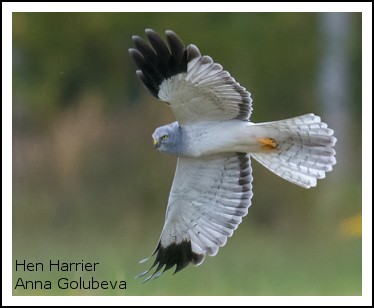 at the at Parkgate old baths where we enjoyed a fly past by two Great White Egrets immediately after our arrival followed by a Sparrowhawk that perched nicely on a convenient post, showing well through the 'scopes; it turned out to be an immature male bird. A few Skylarks and small flocks of Linnets passed overhead whilst in the surrounding fields and trees a good selection of passerines were added to a rapidly expanding day-list. Back on the marsh a huge flock of 1,000+ Lapwings, Greylag and Pink-footed Geese, a Peregrine falcon and Marsh Harriers but pride of place went to a fine male Hen Harrier that floated slowly past heading up-river towards Burton. at the at Parkgate old baths where we enjoyed a fly past by two Great White Egrets immediately after our arrival followed by a Sparrowhawk that perched nicely on a convenient post, showing well through the 'scopes; it turned out to be an immature male bird. A few Skylarks and small flocks of Linnets passed overhead whilst in the surrounding fields and trees a good selection of passerines were added to a rapidly expanding day-list. Back on the marsh a huge flock of 1,000+ Lapwings, Greylag and Pink-footed Geese, a Peregrine falcon and Marsh Harriers but pride of place went to a fine male Hen Harrier that floated slowly past heading up-river towards Burton.By now it was approaching noon and as the high tide wasn't due until 1pm we decided to walk along the quayside up to the Parkgate chip shop, this is a fine establishment - one of our members - an iconic figure in the world of dominoes and crown green bowling who likes to keep in shape for these extreme activities eats fish and chips only once a year - always at the Parkgate chippie - he wasn't disappointed and neither were we! The high tide was a bit of a let-down and apart from a single Snipe I don't think we saw any new species as the incoming water remained just a grey streak in the distance. On then to the RSPB's Burton Mere Wetlands Centre, busy with people arriving from Parkgate but quite a disappointing species count after reports seen online over the past few weeks - Kingfisher, a Grey Wagtail and a pair of Stonechats were probably the highlights; apart from the fact that you can now buy a very nice cup of filter coffee from the reception centre for £ 1:60!
On Saturday, and unsurprisingly given the weather, we managed only 25 species during the allotted one hour time period, six down on last year and 10 less than we managed in 2016. As usual Black-headed Gulls were the most numerous (60) but good numbers of Canada Geese (25) Jackdaws (30) and Mallard (25). A flock of 20 Siskins fed high in the trees at the northern edge of the area we cover with more birds further towards Dog Wood. Interestingly on neither day did we see a single Starling - a species in steep decline despite the well-publicised winter "murmurations" that must consist mainly of winter visitors from continental Europe.
Just a couple of hours but most enjoyable and great to see some youngsters involved; we're just a tiny part of this huge exercise - the biggest example of citizen science on the planet - well done everyone! On Friday (2nd) it's the CAWOS (Cheshire and Wirral Ornithological Society) February meeting when Brian Anderson will be presenting a talk entitled "Stinkers, Pintados and Mollymawks". 7:45pm at St. Vincent's Church Hall, Tatton Street. The following morning (3rd) it's our KOS February field trip over to the Wirral Peninsula for the high tide, Parkgate to begin with then over to Burton Mere Wetlands Centre (via the Parkgate chippie!). Meeting up in Lilac Avenue at 08:50am ready to leave at 9:00am prompt. 22/01/2018...... Winter days with the KOSThe weather forecast for Saturday (20th) was most encouraging with the Met. Office promising dry and sunny weather all day right through the preceding week. Unfortunately on Friday evening they had to admit they'd got it 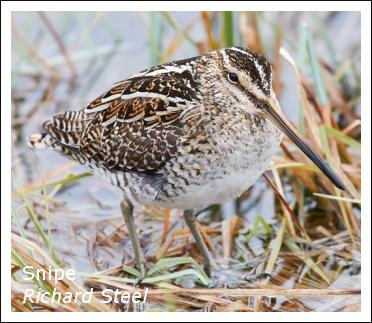 wrong - very wrong and conditions would be less than ideal for our trip over to the Deeside Naturalists' Connah's Quay reserve. wrong - very wrong and conditions would be less than ideal for our trip over to the Deeside Naturalists' Connah's Quay reserve.Volunteers Bob Lee and his wife Betty met us at the entrance to the reserve and directed us to the information centre that had been opened so that we visitors could use the facilities. After a quick introduction to the reserve and the birds we could expect to see we set off towards the west hide at the far end of the reserve, pausing at the three other hides we passed en route. Shelduck, Redshank and Wigeon were the most obvious species out on the marsh, a few small birds were using the feeding station - Great Tit, Blue Tit, Chaffinch, Goldfinch etc. whilst on the adjoining fields large numbers of Curlew and Lapwings were feeding accompanied by a single Golden Plover - apparently quite a rare visitor with only one record during 2016 in the reserve's latest annual report. By the time we reached the west hide the drizzle we'd endured on the walk up had abated but it was still perishing - a maximum of only 1 ° C all day! Visibility remained poor throughout, we could make out flocks of geese over towards Burton and Parkgate, too far away to identify properly but in all probability Pinkfeet. A flock of 130 Dunlin were pushed off the mud as the tide came in and a Common Sandpiper was an unusual sighting given the time of year. Inland we were very disappointed that the Twite failed to appear for us this year; apparently it's something to do with their favourite pool (I think it's called the fly ash lagoon) where they drink and bathe being polluted with salt used to kill off invasive New Zealand pigmy (yes it's spelt correctly) pond weed and they now spend their time over towards Flint Castle. We ended the day back at the information centre where Bob and Betty provided hot drinks to help us thaw out! Our thanks go to them and the other members of the Deeside Naturalists' who made us so welcome.
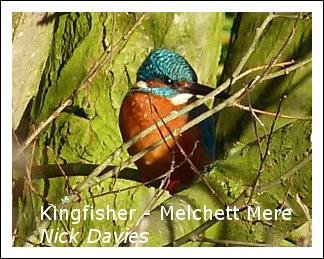 makings" for hot tea and coffee and had things set up when the rest of us arrived; nine members in total - a good turnout considering the weather. By kick off time at 11:00am the early rain had changed to heavy snow and Melchett Mere had taken on a magical appearance, so different from its usual drab winter garb! makings" for hot tea and coffee and had things set up when the rest of us arrived; nine members in total - a good turnout considering the weather. By kick off time at 11:00am the early rain had changed to heavy snow and Melchett Mere had taken on a magical appearance, so different from its usual drab winter garb! Some good birds too Great Crested Grebe, Coot, Moorhen, Mallard, Teal, Tufted Duck, Mute Swan, Goldeneye - all to be expected plus three Pintail and a Barnacle Goose amongst the Canadas and a mobile flock of 34 Snipe who put on a fine display as they circled the mere in the early whiteout. Our first visitor of the day was Alan Gillespie a local birder who'd been to all the previous events and it was he who discovered a female Goosander, bird of the day! The weather was obviously keeping people at home and we had fewer visitors than last year although once again the promise of free drinks was enough to tempt a trickle of folk over the two hours we were open. During the past couple of weeks members have reported a Kingfisher perched nicely over the outlet channel where Melchett overflows into Tatton Mere's own overflow stream. It was there again on Sunday and we were able to point visitors to the spot where they could see it - it's amazing how many people have never seen one "in the flesh"! Don't forget that this coming Friday (26th) it's our January indoor meeting when Jim Almond will be telling us all about Springtime in New England.
A happy and healthy New Year to all KOS members and any others who pass this way from time to time. Apologies for leaving things so long since the last update but, like many others, I've been struck down by one of this season's 'flu bugs and in addition I pulled a calf muscle running for the metro after United's last match of 2017 and recovery is taking quite some time! A few people have been out braving the elements - up to 6 Hawfinches remain at Marbury Park, Later this month our KOS committee will be meeting to discuss the programme from May 2018 through to May 2019. Last year as well as the normal indoor and outdoor events we enjoyed the Scottish week in June and Lindisfarne at the end of September, perhaps we'll have another weekend away later this year and no doubt due consideration will be given to the possibility of a week abroad to celebrate our 45th anniversary in 2019! Input from members is always welcome regarding any of the Society's activities - indoor or outdoor - praise or constructive criticism, your wish is our command! 30/12/2017...... Seasonal conditions for the Christmas walkIt would appear that whilst members appreciate ice and snow on their Christmas cards when it comes to the real thing they're reluctant to leave their firesides for a bracing walk around the Northwich Woodlands! So it was only a small group of stalwarts [noun: a loyal, reliable, and hard-working supporter of or participant in an organization or team] who braved the elements for the Christmas walk (29/12). It was pretty bad though I must admit! Heavy rain overnight that changed into wet snow at around 9:00am with a temperature of only 1 ° C as we set off from the car park next to the Stanley Arms. The path alongside the River Weaver was a bit tricky; frozen compacted mud with a topping of melting snow - eyes down rather than scanning the landscape for birds. 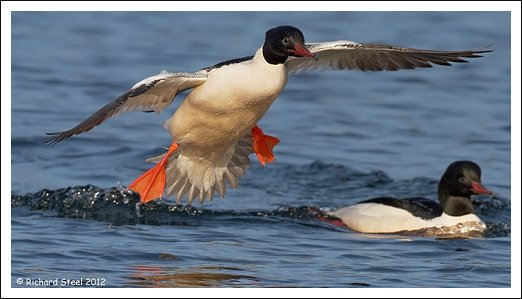 Teal, Cormorant, Mallard, Moorhen and a single Great Crested Grebe were all noted on the river before we took the steep steps up from the path to Haydn's Pool. The pool was pretty much deserted just a couple of Snipe and in the distance, surveying it's domain from the top of one of the old ICI chimneys, a lone Peregrine. Teal, Cormorant, Mallard, Moorhen and a single Great Crested Grebe were all noted on the river before we took the steep steps up from the path to Haydn's Pool. The pool was pretty much deserted just a couple of Snipe and in the distance, surveying it's domain from the top of one of the old ICI chimneys, a lone Peregrine.A bit more of interest in the woodland adjacent to Budworth Mere and on the mere itself where the highlight was a group of Goosanders - 2 fine males and 7 female/immature birds in a flotilla close to the mereside opposite the sailing school. The usual mix of woodland species - Jay, Treecreeper, Bullfinch, Nuthatch as we made our way to the viewing screen where Blue, Great and Coal Tits were feeding; both Great Tits and Coal Tits were in song during the morning. Up to six Hawfinches have been seen in the Old Hall area but once again we missed out although we did have a quick scan before making our way back to the cars; 3 hours in total which helped to blow the Christmas cobwebs away. Passerines seemed to be down in numbers this year, I'm guessing that many species are taking advantage of garden feeders. We have two, one of which was designed and built by a friend and features the usual wire mesh front but which additionally curves round underneath at the bottom. It's filled with sunflower hearts and is attracting large numbers of Green and Goldfinches, especially the latter with up to 20 at any one time. The seeds are also dislodged from the bottom mesh onto the ground where they're consumed by Blackbirds, Dunnocks, House Sparrows, Chaffinches and recently 4 Bramblings. There's a three week break now before our next KOS group activity beginning on the 20th January with the trip to Connah's Quay followed the next day by the Tatton Wildfowl Event in conjunction with the Tatton rangers. On the 26th it's the January indoor meeting with Jim Almond followed by the Great Garden Birdwatch on Knutsford Moor (27th) with the Friends of the Moor group and finally on the 28th we repeat the Garden Birdwatch with the Friends of Knutsford Heath.
19/12/2017...... A record breaking Christmas party! A busy weekend for KOS members with the annual Christmas party on Friday (15th) followed on Sunday (17th) by the trip up to Marshside and Martin Mere. The party went very well and, as our treasurer Frank Dearden reports in his email, we made a welcome profit during the evening. Greetings, Attendance £ 224.00 Raffle and bird lottery £ 67.00 Bring and buy/Auction £ 41.80 Total income £ 332.80 Expenses £ 36.40 Profit £ 296.40 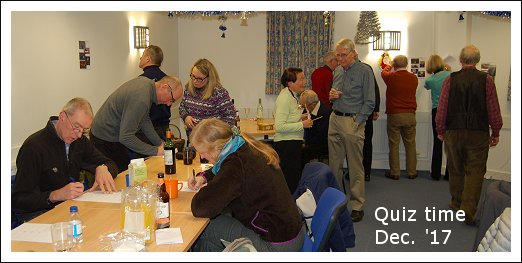 Twenty-four people were in attendance on the night but some who could
not be there sent in donations to compensate so the attendance money is
equivalent to twenty-eight persons.
Securing quality speakers for our small society is an expensive business
and we, quite reasonably, want to offer the best lectures we can to our
members. The average cost for a lecturer is currently
£
120 per visit so
the profit generated by yesterday's efforts buys us 2.5 speakers. That
is approaching half of a whole season's expenditure on lecturers and
reinforces how important the Christmas party is in generating funds to
keep the Society going in its current format.
To all those who contributed their time, effort or funds to staging last
night's event, and to those who came and opened their purses/wallets, a
great big thank you from the man who takes care of the cash.
Merry Christmas,
Frank
Thanks Frank, as efficient as ever, we were all glad to see you back in circulation and in such good form! Twenty-four people were in attendance on the night but some who could
not be there sent in donations to compensate so the attendance money is
equivalent to twenty-eight persons.
Securing quality speakers for our small society is an expensive business
and we, quite reasonably, want to offer the best lectures we can to our
members. The average cost for a lecturer is currently
£
120 per visit so
the profit generated by yesterday's efforts buys us 2.5 speakers. That
is approaching half of a whole season's expenditure on lecturers and
reinforces how important the Christmas party is in generating funds to
keep the Society going in its current format.
To all those who contributed their time, effort or funds to staging last
night's event, and to those who came and opened their purses/wallets, a
great big thank you from the man who takes care of the cash.
Merry Christmas,
Frank
Thanks Frank, as efficient as ever, we were all glad to see you back in circulation and in such good form!
On Sunday Marshside lived up to it's reputation as being one of the coldest places on earth! Dry as we left Knutsford but when we reached our destination it was raining heavily and the temperature was reluctant to rise above only 3
°
C. so it was off immediately to the shelter of the Sandgrounder's hide. It wasn't much warmer in there but at least it was dry. Given the time of year there weren't many people at Martin Mere although a few brave kids seemed to have persuaded their parents to "Sail to Santa" across the water in front of the reception building where we ate our lunch before moving to the restaurant for a coffee. The highlight of the afternoon came as we sat in the Ron Barker hide and watched five Marsh Harriers quartering the reedbeds. Apparently, earlier in the day, there were seven in view at the same time! There was the usual scrum at feeding time with 1,600 Whooper Swans and a sea of Shelducks hoovering up the grain but we saw only a couple of Ruff this time despite a count of 83 during the morning. A reminder that this year's Christmas walk will take place on Friday 29th December meeting up at the public car park next to the Stanley Arms in Anderton at 09:45am. Derek has a 4.3 mile walk planned which, with stops, should take us about three hours.
| |||||||||||||||||||||||||||||||||||||||||||||

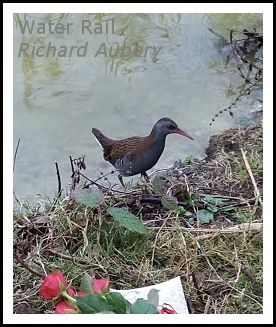

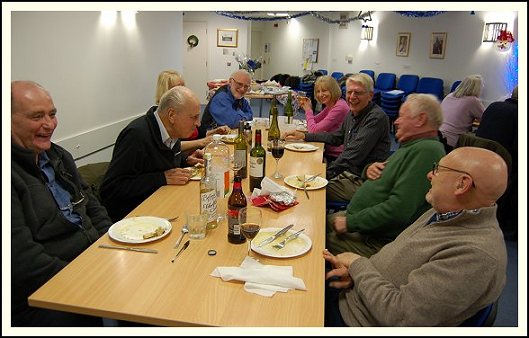
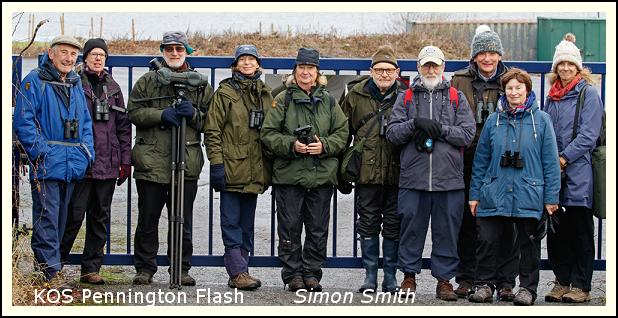
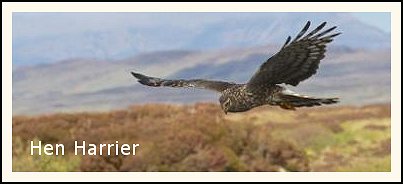 that the birds performed in the appropriate manner! Bob Groom was there at dusk on Sunday (25th) and was lucky enough to see the wintering Bittern as well as the Starlings. " Marbury/Budworth Mere - Starlings came down in waves from 3.55 to 4.15 PM, rather than a mass murmuration. Sparrowhawks were in attendance and at least one Starling fell victim to them. Just after 4.20 PM, when only 2 of us were left watching, the Bittern flew from left to right over the reedbed and then started to make its 'night-nest', pulling reed fronds together over it. Despite the gloom it was quite conspicuous in flight as it is a very pale bird. "
that the birds performed in the appropriate manner! Bob Groom was there at dusk on Sunday (25th) and was lucky enough to see the wintering Bittern as well as the Starlings. " Marbury/Budworth Mere - Starlings came down in waves from 3.55 to 4.15 PM, rather than a mass murmuration. Sparrowhawks were in attendance and at least one Starling fell victim to them. Just after 4.20 PM, when only 2 of us were left watching, the Bittern flew from left to right over the reedbed and then started to make its 'night-nest', pulling reed fronds together over it. Despite the gloom it was quite conspicuous in flight as it is a very pale bird. "
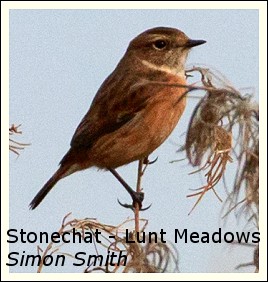
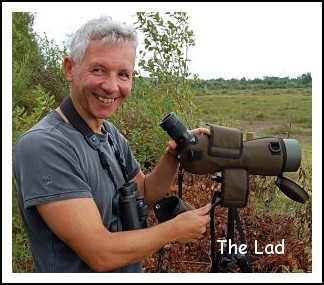 Barrie is a product of our long defunct KOS junior section and, for those who've never met him, his recent emails will illustrate the type of character you're dealing with!!
Barrie is a product of our long defunct KOS junior section and, for those who've never met him, his recent emails will illustrate the type of character you're dealing with!!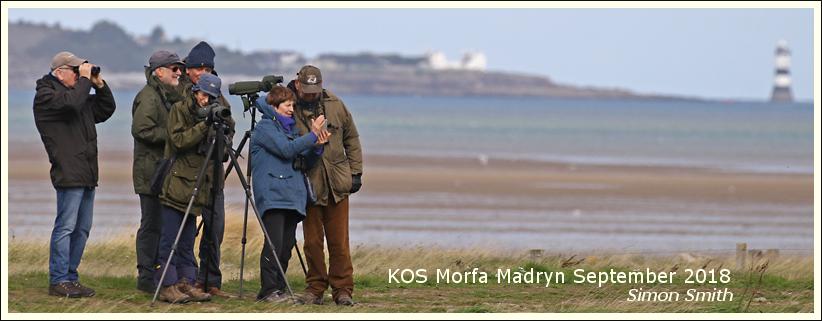
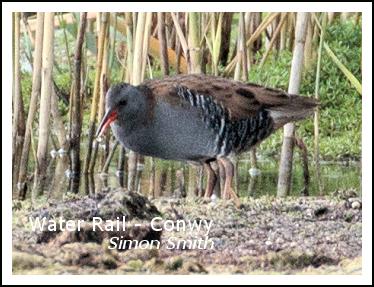 it had nearly stopped, although it was quite cold; yet on way back from far hide Sheila took two layers off so you could see how warm it had become!
it had nearly stopped, although it was quite cold; yet on way back from far hide Sheila took two layers off so you could see how warm it had become!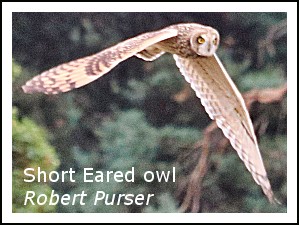
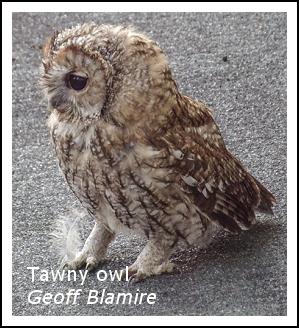 It was a youngster - obviously fledged but still had downy feathers on its head. There was a tell-tale mark on the library window. It was concussed. I rang the Lower Moss Wildlife Hospital, but no answer so I left a message.
It was a youngster - obviously fledged but still had downy feathers on its head. There was a tell-tale mark on the library window. It was concussed. I rang the Lower Moss Wildlife Hospital, but no answer so I left a message.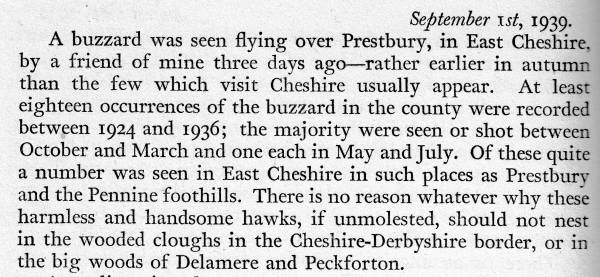
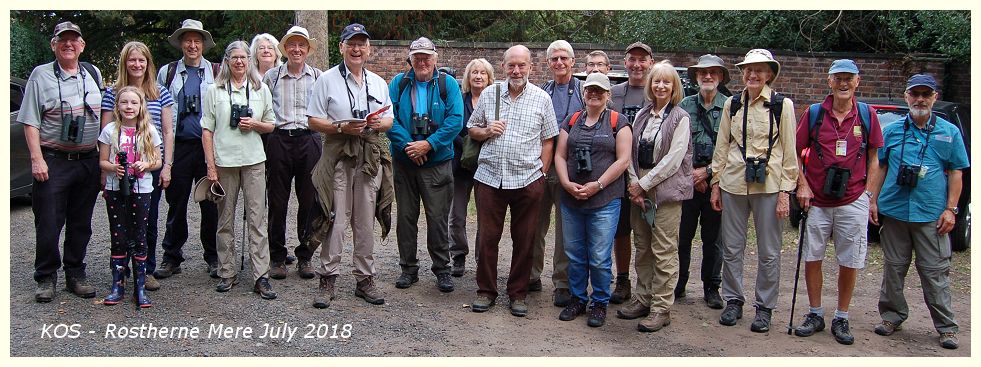
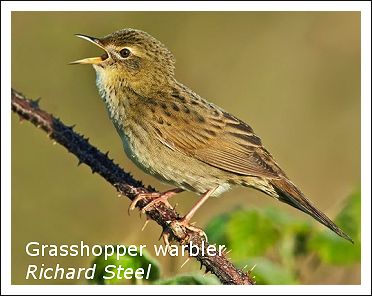
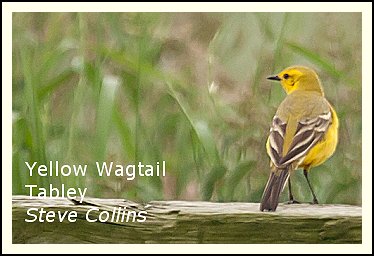 It's at this time of the year that post breeding flocks should start to gather locally and I've seen 200+ in years gone by but I fear those days are over for this beautiful, iconic species.
It's at this time of the year that post breeding flocks should start to gather locally and I've seen 200+ in years gone by but I fear those days are over for this beautiful, iconic species.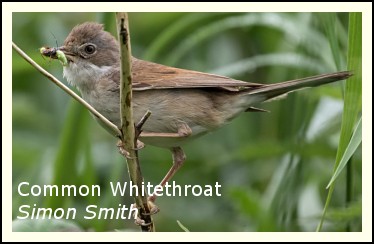 straying too far from their parents.
straying too far from their parents.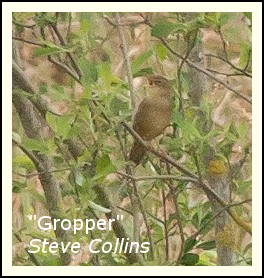 day lead us along the "meadow trail" beside the River Ribble and back to the most productive of the hides before heading for home. The river was quiet compared with the rest of the reserve but from the final hide we did add Dunlin to the list giving a respectable total of 54 species for the day.
day lead us along the "meadow trail" beside the River Ribble and back to the most productive of the hides before heading for home. The river was quiet compared with the rest of the reserve but from the final hide we did add Dunlin to the list giving a respectable total of 54 species for the day.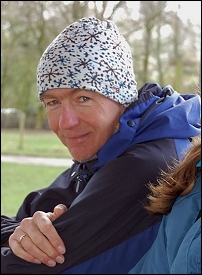

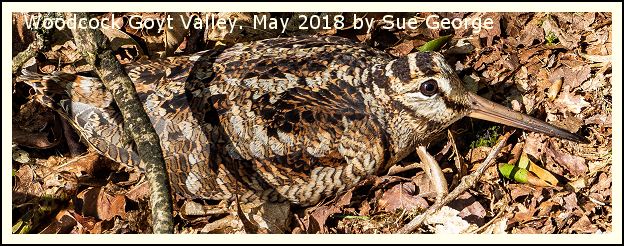
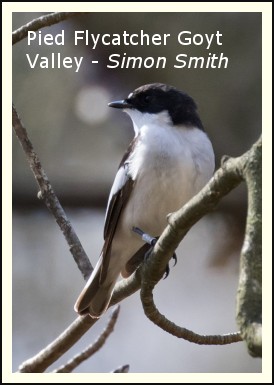 home and a slightly smaller raptor made a welcome return this week when Darren Morris reported the first Hobby of the year hawking for insects over Tatton Mere on Friday evening (27th) with two birds at the same location two days later.
home and a slightly smaller raptor made a welcome return this week when Darren Morris reported the first Hobby of the year hawking for insects over Tatton Mere on Friday evening (27th) with two birds at the same location two days later. 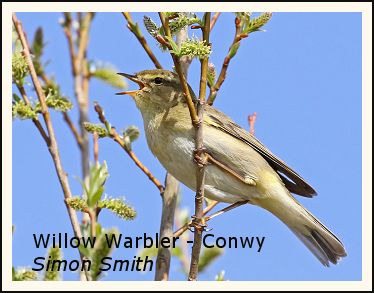 it's staffed by volunteers and the food is excellent - I can recommend the bacon baps!
it's staffed by volunteers and the food is excellent - I can recommend the bacon baps!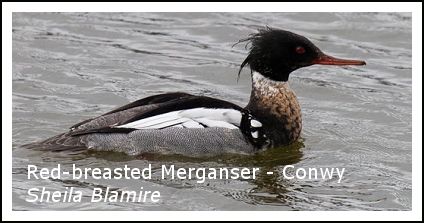 the past few years. Stars of the show on the Orme were the corvids, Jackdaws were revelling in the windy conditions - tumbling acrobatics over the road, more at home here than in our Cheshire flatlands where they rarely get to show off their flying skills! Even more excitement when we heard the unmistakable sound of a Chough which put on a virtuoso performance as it displayed overhead, the almost electronic sounding call echoing off the cliff faces.
the past few years. Stars of the show on the Orme were the corvids, Jackdaws were revelling in the windy conditions - tumbling acrobatics over the road, more at home here than in our Cheshire flatlands where they rarely get to show off their flying skills! Even more excitement when we heard the unmistakable sound of a Chough which put on a virtuoso performance as it displayed overhead, the almost electronic sounding call echoing off the cliff faces.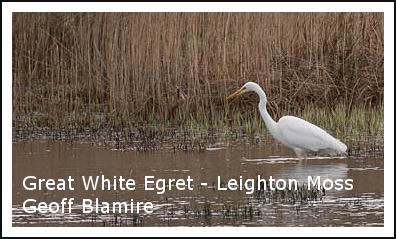 Making our way back from the hides we came across the Marsh Tits and enjoyed brilliant views, down to a few feet in good light - they were in pristine early Spring plumage - Excellent!
Making our way back from the hides we came across the Marsh Tits and enjoyed brilliant views, down to a few feet in good light - they were in pristine early Spring plumage - Excellent!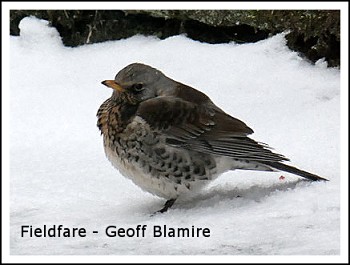 Lapwings 300++; Golden Plover 40; Fieldfare 60 Plus Starlings and loads of Black-headed Gulls.
Lapwings 300++; Golden Plover 40; Fieldfare 60 Plus Starlings and loads of Black-headed Gulls.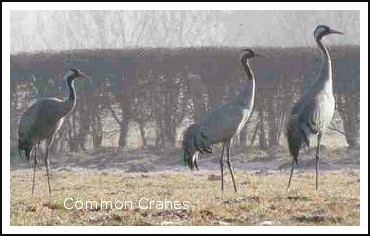 a Red Breasted Goose and C.90 Barnacle Geese.
a Red Breasted Goose and C.90 Barnacle Geese.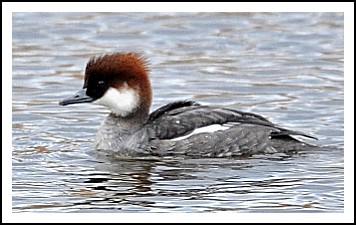 Tufted Ducks, trilling Little Grebe, Great Crested Grebe etc. and I thought I heard a water rail in the reedbed. Be interesting to visit in spring..
Tufted Ducks, trilling Little Grebe, Great Crested Grebe etc. and I thought I heard a water rail in the reedbed. Be interesting to visit in spring..
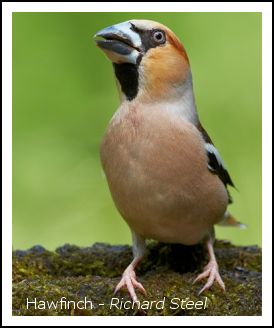 I spent a couple of hours in the peace and quiet of the Rostherne observatory on Tuesday (13th) evaluating the combination of 'scope and clamp; they performed very well, although the magnification is only 20X the 'scope lets in a lot of light and, compared with my 8X binoculars, I was able to identify the various wildfowl species at the mouth of Rostherne brook (including a female and 2 male Mandarin ducks), determine the sex of a Great Spotted Woodpecker on the split lime and identify a group of Goosanders at the far end of the mere, the best part of a kilometer away - all impossible with just the binoculars.
I spent a couple of hours in the peace and quiet of the Rostherne observatory on Tuesday (13th) evaluating the combination of 'scope and clamp; they performed very well, although the magnification is only 20X the 'scope lets in a lot of light and, compared with my 8X binoculars, I was able to identify the various wildfowl species at the mouth of Rostherne brook (including a female and 2 male Mandarin ducks), determine the sex of a Great Spotted Woodpecker on the split lime and identify a group of Goosanders at the far end of the mere, the best part of a kilometer away - all impossible with just the binoculars.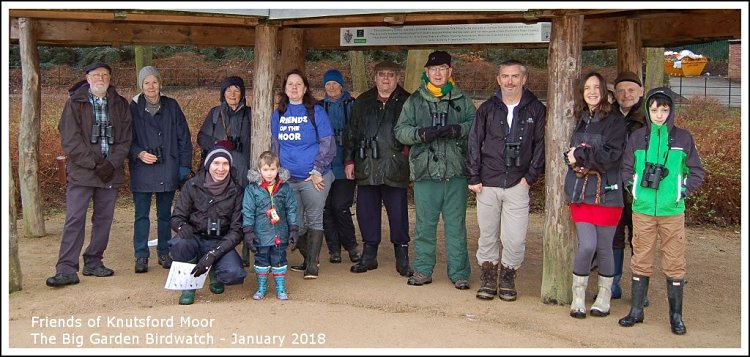
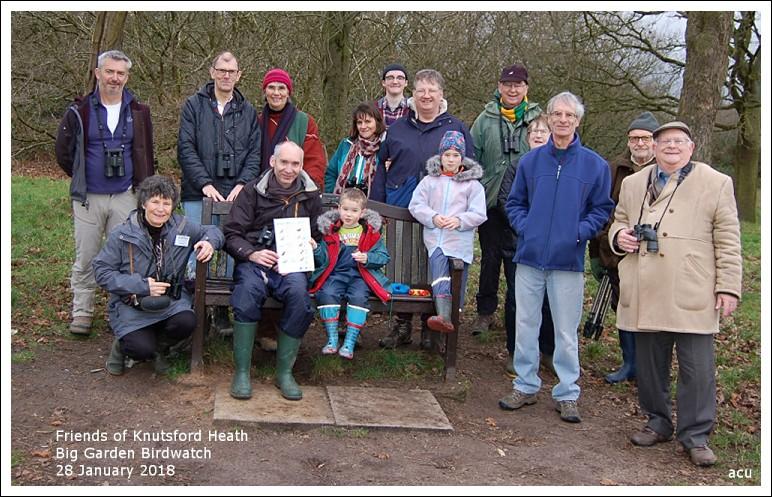
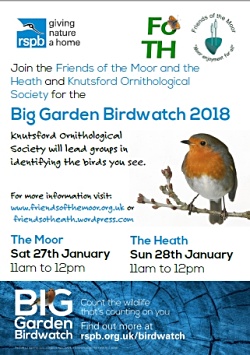 they were seen at the end of December by Sue Middleton ( a new species for Sue), Darren Morris and Bob Groom , Derek Pike had 47 Lapwings on the big fields opposite the entrance to Lilac Avenue on 26th December, increasing to 112 on New Year's day - this is less than half a mile from Knutsford town centre and the site earmarked for a development of 260 new homes as part of the local councils "Vision for Cheshire East in 2030". Derek and Jean spent some time in Tatton over the new year and on the 7th January had two Green Woodpeckers calling and two Ravens displaying - the latter are very early nesters so hopefully they'll be setting up shop in the park once more. Tatton Ranger Darren Morris tells me they had 10 Woodcock in Hanging Bank on the 7th and whilst cleaning out nest boxes (they have 30) found that 90% had been used in 2017. It's hoped to attract Pied Flycatchers to the park and to this end some boxes are plugged until mid-May to prevent members of the Tit family from moving in before the flycatchers return.
they were seen at the end of December by Sue Middleton ( a new species for Sue), Darren Morris and Bob Groom , Derek Pike had 47 Lapwings on the big fields opposite the entrance to Lilac Avenue on 26th December, increasing to 112 on New Year's day - this is less than half a mile from Knutsford town centre and the site earmarked for a development of 260 new homes as part of the local councils "Vision for Cheshire East in 2030". Derek and Jean spent some time in Tatton over the new year and on the 7th January had two Green Woodpeckers calling and two Ravens displaying - the latter are very early nesters so hopefully they'll be setting up shop in the park once more. Tatton Ranger Darren Morris tells me they had 10 Woodcock in Hanging Bank on the 7th and whilst cleaning out nest boxes (they have 30) found that 90% had been used in 2017. It's hoped to attract Pied Flycatchers to the park and to this end some boxes are plugged until mid-May to prevent members of the Tit family from moving in before the flycatchers return.